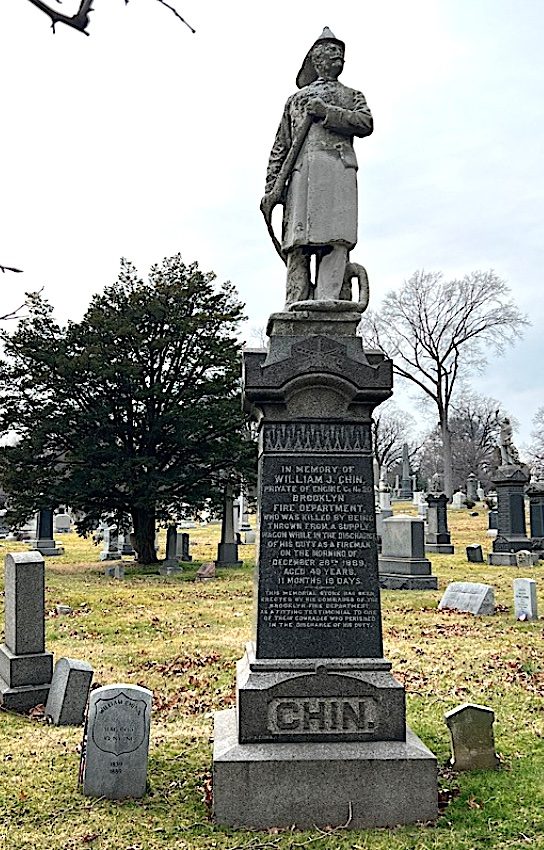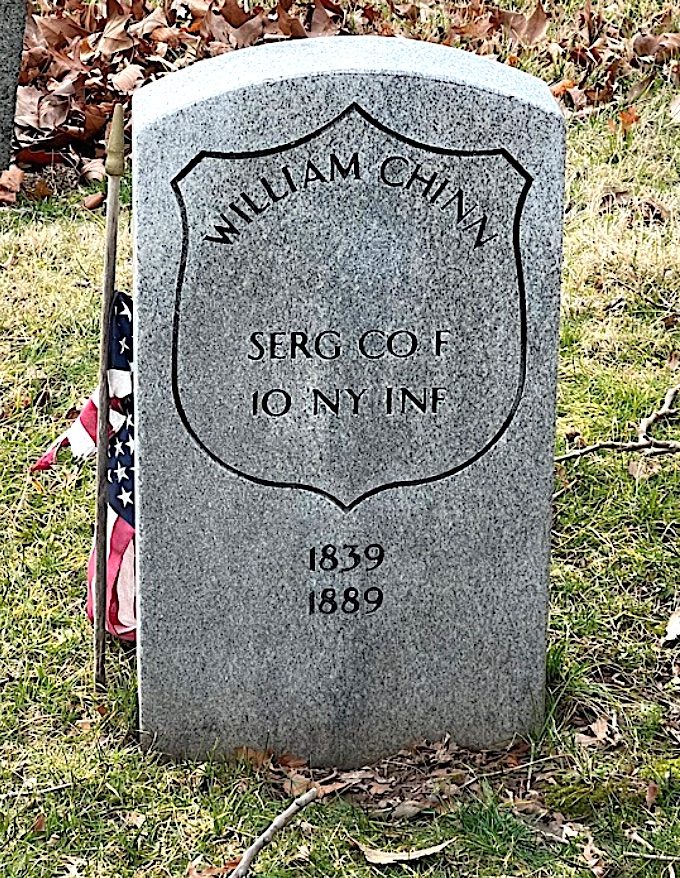CALHOUN, ALFRED ROCHEFORT (or A.R.) (1844-1912). Major, unknown Kentucky Union regiment. Calhoun, who was born in Kentucky, joined a Kentucky Union regiment at the onset of the Civil War and served until he end of the hostilities, despite sustaining two serious wounds, capture and imprisonment at Libby Prison in Richmond, Virginia. While imprisoned, he took part in the efforts to dig an escape tunnel; he escaped through it. On an unknown date, he delivered a lecture, “Prison Life in the Land of Chivalry,” to a Ladies’ Aid Society for the benefit of wounded soldiers in Weldon, Pennsylvania.
Civil War Bio Search
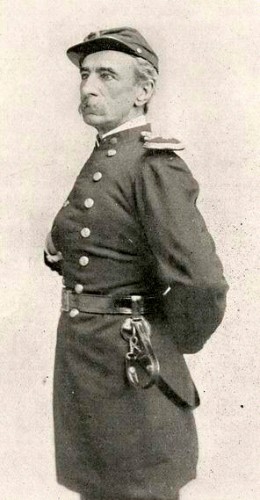
Returning to civilian life, Calhoun’s career was quite extensive. He worked as a railway survey artist, photographer, writer and special artist for Harper’s Weekly and the Philadelphia Press. A member of the Union Pacific survey party led by General Wright and Dr. William Bell through Arizona, New Mexico, and Colorado in the 1860s, he befriended Kit Carson and other famous scouts and pioneers, and was known for his descriptive and entertaining accounts of skirmishes with Indians. In 1867, an illustration of a battle and a view of Fort Wallace in the Kansas territory were published by Harper’s from his sketches. He is listed as a journalist in the Brooklyn Directories for 1880-1882 and 1890-1892.
In addition to his other accomplishments, Major Calhoun collaborated on a play, The Color Guard, which contained the popular songs, “Marching Through Georgia,” and “Tramp, Tramp, Tramp.” He wrote a number of books including Kohala of Hawaii: A Story of the Sandwich Islands Revolution. A description of Alfred Rochefort Calhoun appears in The Autobiography of a Pennsylvanian by Samuel Whitaker Pennypacker (a former governor of Pennsylvania). A Letter to the Editor published in The New York Times upon his death noted that he was an accomplished journalist and man of letters. He last resided at 376 State Street in Brooklyn. His obituary in The New York Herald notes that he was cremated at Fresh Pond Crematory in Queens. Section 87, lot 1715, grave 535.
CALKINS, BYRON (1844-1926). Private, 77th New York Infantry, Company A. Calkins served as a private in the 77th New York, enlisting on April 6, 1865, at Amsterdam, New York, and mustering out on June 27, 1865, at Washington, D.C. According to the census of 1880, he was living in Peekskill Village, New York, and was employed as a railroad conductor. An article published March 13, 1888, in The New York Times notes that he was the conductor of a train that was struck by another train while standing at the station at Dobbs Ferry, New York, during a blinding snowstorm the previous evening, causing a number of injuries to passengers.
The New York City Directories for 1894-1895, 1895-1896 and 1897-1899 list Calkins as a collector. His military service in the Civil War was confirmed by the Veterans Schedule of 1890. The censuses from 1900, 1910, and 1920 indicate that he earned a living as a bill collector for the gas company. He was a member of the Freemasons. The Roll of Registered Voters in New York City for 1924 lists Calkins as living in Queens. His last address was 101-57 123rd Street in Richmond Hill, Queens. Calkins died from pneumonia. Section 148, lot 21760.
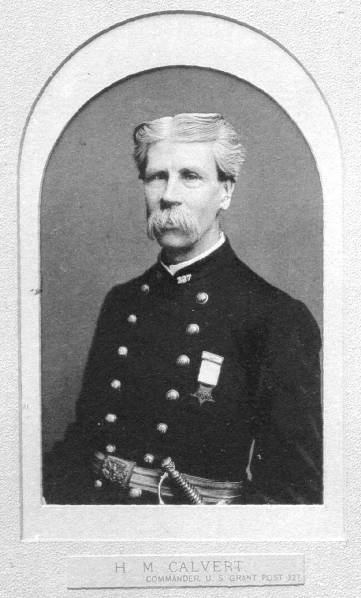
CALVERT, HENRY MURRAY (1830-1925). First lieutenant, 11th New York Cavalry, Companies F and M. Born in St. Lucia, in the British West Indies, he came to the United States in 1862 and promptly offered his services in defense of the Union. Enlisting as a private at New York City on April 17, 1862, he mustered into Company F of the 11th New York Cavalry on that date. This regiment was first known as “Scott’s 900 Volunteer Cavalry.” His company first served in Washington, D.C., then did picket duty in the area of the Potomac River before being assigned to the Army of the Gulf. Promotions to corporal on July 24, 1862, sergeant on November 11, 1862, first sergeant on February 8, 1863, and first lieutenant on January 7, 1865, marked milestones in Calvert’s military service. Upon this last promotion he was transferred to Company M on January 14, 1865, and returned to Company F on April 3, 1865. He mustered out on July 21, 1865, at Memphis, Tennessee.
Calvert was employed as a clerk in dry goods after the Civil War. A charter member of the G.A.R.’s Ulysses S. Grant Post #327 and a post commander, he was said to be “one of the most active and ardent supporters of all measures pertaining to the advancement of the G.A.R.” He also played an active role in securing the erection of an equestrian statue of General Grant on Bedford Avenue in Brooklyn. His last residence was 169 McDonough Street in Brooklyn where he died from heart disease at age 94. Section 171, lot 12958.
CAMBRELENG (or CAMBRELLING, CAMBRELING), CHURCHILL J. (1836-1894). Major by brevet; major, 10th Senatorial District Regiment; captain, 5th New York Infantry, Company H. The son of a judge and a lawyer by trade, Cambreleng first served in Company F of the 7th New York National Guard. When the Civil War began, he enlisted at New York City on April 25, 1861, mustered into the 5th New York as a first lieutenant on May 9, and was promoted to captain on September 3. At Yorktown, Virginia, his company served as siege artillerists under his command. Under General McClellan, he engaged in all of the battles of the Peninsula Campaign in Virginia including: Chickahominy, Hanover Court House, Harrison’s Landing, Mechanicsburg, Malvern Hill, Gaines’ Mill and the Seven Days’ Battle.
Cambreleng was praised for brave and gallant conduct in Virginia at the Battles of Big Bethel and Gaines’ Mill including this citation by Hiram Duryea, lieutenant colonel of the 5th New York, who wrote about him and Thomas Cartwright (see) in his field report of July 4, 1862, “Their coolness was particularly shown in preparing for the last charge, just previous to which, the regiment being very much thinned, the ranks were closed and told off with great coolness under the most terrific fire…” Davenport, in his book on the 5th, described him as “much beloved by all.” Major Generals G. K. Warren and Fitz John Porter (see) recommended him for promotion. He was elected major in the 10th Senatorial District Regiment but prolonged sickness resulted in his resignation. He resigned on July 23, 1862, due to ill health caused by exposure during the Peninsula Campaign. Cambreleng was brevetted to major for his service in the War.
He is listed as an agent in the Brooklyn Directories for 1885-1885 and 1885-1886. Remaining active in military affairs, he founded the veterans’ association of the 5th Regiment and served as its secretary. As per his obituary in The New York Herald, he died suddenly in Baltimore, Maryland. He last lived at 238 West 44th Street in Manhattan. His death was attributed to heart valve disease. Section 73, lot 4150.
CAMERON GEORGE A. (1841-1880). Corporal, 14th New York Cavalry, Company H. A native of New York City, Cameron enlisted there as a private on March 12, 1863. On March 28, 1863, he mustered into Company H of the 14th New York Cavalry, was promoted to corporal at some point but then was reduced in rank to private. On April 7, 1863, he deserted from Riker’s Island, New York Harbor. His last residence was 15 Brooklyn Avenue in Brooklyn. Cameron died from tuberculosis. Section 15, lot 17263, grave 2336.
CAMERON, JASON C. (1843-1927). Private, 1st New York Engineers, Company D. A native of Duxbury, Vermont, Cameron enlisted as a private at New York City on March 9, 1865, mustered into the 1st New York Engineers ten days later, and mustered out on June 30, 1865, at Richmond, Virginia. He may be the Jason C. Cameron listed as a foreman/superintendent in the Brooklyn Directories for 1873-1876, 1880-1882 and 1890-1892. In 1899, his application for an invalid pension was approved, certificate 998,916. As per his death certificate, Cameron was a retired railway worker. His obituary in the Brooklyn Daily Eagle notes that his funeral took place at the funeral home of John T. Collins in Rutherford, New Jersey. He last lived at 147 Home Avenue in Rutherford. He died from chronic myocarditis. A widower, he was survived by two sons and a daughter. Section 142, lot 24032.
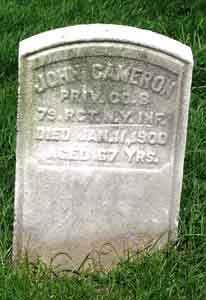
CAMERON, JOHN (1826-1900). Sergeant, 79th New York Infantry, Company B. Of Irish origin, Cameron enlisted as a private at New York City on May 13, 1861, and mustered into the 79th New York on May 28. Promoted to sergeant at some point during his service, he was reduced to ranks on February 8, 1864, and mustered out at New York City on May 31, 1864.
According to the census of 1880, Cameron was employed as a longshoreman. The 1890 Veterans Schedule, which confirms his military duty, notes that he was wounded in the shoulder while in service. In 1890, his application for an invalid pension was approved, certificate 850,424. He last lived at 132 Duffield Street in Brooklyn. Violet Cameron, who is interred with him, applied for and received a widow’s pension shortly after his death from nephritis, certificate 501,261. Section 135, lot 30010, grave 732.

CAMERON, ROBERT H. (1842-1891). Corporal, 90th New York Infantry, Company H; ensign, United States Navy. A native of Scotland, he enlisted and mustered into the 90th New York on November 22, 1861, and was discharged for disability on March 6, 1862, at Key West, Florida. According to the 1890 Veterans Schedule, he was also an ensign in the United States Navy. Cameron served on a gunboat, the USS Linden, in the Mississippi Squadron after enlisting on January 24, 1863. The Linden took an active role in the siege of Vicksburg, Mississippi, in the spring of 1863 but on February 22, 1864, she hit a snag in the Arkansas River and sank. He was discharged on August 24, 1864.
As per the New York City Directory for 1880-1882, Cameron was a clerk; the 1882-1883 New York City Directory lists him as a publisher at 21 Park Row. In the latter directory, he lived at 604 Franklin Avenue in Brooklyn. The 1890 Veterans Schedule notes that he suffered from rheumatism and varicocele as a result of his military duty. Cameron last lived at 604 Franklin Avenue in Brooklyn. The cause of his death was mitral regurgitation (a heart valve disorder). Section 135, lot 27263, grave 1299.
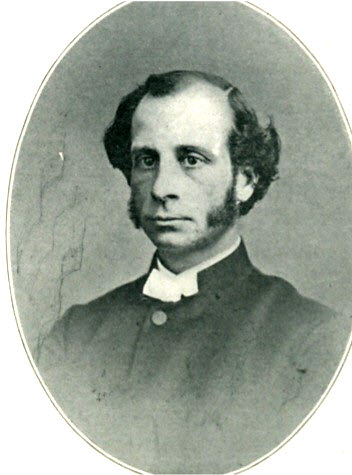
CAMERON, STEPHEN F. (1833-1878). Chaplain, Confederate States of America. Cameron was born in Philadelphia, Pennsylvania, and lived in Elkton, Maryland. An Episcopal chaplain for the Confederacy, he wrote two patriotic songs, God Save the Southern Land and Close Up the Ranks. First serving as chaplain for the 1st Maryland, he enlisted on July 4, 1861, and his appointment was accepted two days later. A request was made on November 5, 1862, by Colonel W. B. Tabb to appoint Cameron to the 59th Virginia Volunteers. Tabb wrote, “…From authority which I regard with the highest confidence, I am fully assured of his capacity and zeal for usefulness. He already holds the appointment as chaplain in the C.S. Provisional Army. Your favorable endorsement of this paper will ensure his assignment to your Brigade.” In 1863, he went to London, England, ostensibly to arrange for the publication of prayer books, but in fact was engaging in activities on behalf of the Confederacy.
The Lee Family Digital Archive includes this letter from Cameron to General Robert E. Lee, dated February 13, 1864:
General
I have the honor to offer for your acceptance, a sword especially designed by a son of Maryland, for your use in the camp and field, bearing your name on the one side of the blade and on the reverse the motto, “Aide toi et Dieu t’aideras” (Help yourself and God will help you). It is not offered in the vain assurance of individual appreciation of your eminent deserts, but as an earnest of the devoted attachment which is entertained for you, General by every true patriot of that renewed and gallant, though now down-trodden State.
To you as the great defender of a sacred and glorious cause, wise in council & humane in the hour of victory, trusting rather in the Providence of God than in the might of man & right, belongs the sword, with the sacred cross emblazoned on the hilt, as once the emblem of our hope and promise of assured success. This sword I have the honor to ask you to accept, with the accompanying note from the donor, as the representative commander of as brave an army as ever marched to battle, and of “sun burned veterans” whose names are honored as confederate soldiers, throughout Europe and the civilized world and who have proved themselves heroes in deeds of unsurpassed endurance and daring.
It may be a source of gratification in your life of hardship and high responsibility to know that fervent prayers follow your steps and that whilst your contemporaries glory in your achievements, faithful history must record your fame, in pages of living truth.
I shall at once hasten to offer this gift personally, or if you see proper to appoint a time and place, await your orders, remaining Sir
Most respectfully
Your Obt [obedient] Servant
S.F. Cameron
In 1864, the renowned Brigadier General John Hunt Morgan requested that Cameron be appointed to his cavalry brigade. On September 6, 1864, he delivered the eulogy for General Morgan who was killed while trying to escape from a Union raid near Greeneville, Tennessee. Cameron was also associated with the aftermath of the raid on St. Albans, Vermont, on October 19, 1864. The raid was meant to obtain money for the Confederacy and cause confusion on the Northern border. Three banks were robbed of more than $200,000, horses were stolen, one citizen was killed and two were wounded; efforts to burn the town were unsuccessful. The Confederate raiders escaped to Canada, were pursued by Vermonters, and eventually some were captured and arrested by Canadians. Canada, a British colony at the time, refused to extradite the raiders, and eventually released them, straining relations between the United States and Great Britain. According to the papers of Jefferson Davis, Cameron met with Davis on February 2, 1865, and then was dispatched as a Confederate messenger to take documents to Canada to aid in the raiders’ defense. While on this mission for Davis, Cameron dressed as a priest when he crossed the Potomac and was accompanied by two women spies who dressed as nuns. The threesome were fired upon but escaped and completed their assignment.
Cameron also was called to testify at the trial of John H. Surratt, who was accused of conspiring with John Wilkes Booth in the assassination of President Abraham Lincoln. Surratt, who had met with Booth, testified that he was in Elmira, New York, on a spying mission for General Robert E. Lee on the day of the assassination, and did not know of the plot. Surratt later fled to Canada, then to Egypt where he was arrested in 1867 and brought to Washington, D.C., for a civilian trial which ultimately ended in a hung jury. Records of that trial indicate that Cameron, one of 170 witnesses, applied for and received a pardon for his role in the War. The pardon was granted on July 4, 1867, by President Andrew Johnson. He died from tuberculosis at New York City Hospital. Originally interred in Section 77, lot 8319, Cameron’s remains later were removed to their current location. Section 122, lot 17806, grave 158.
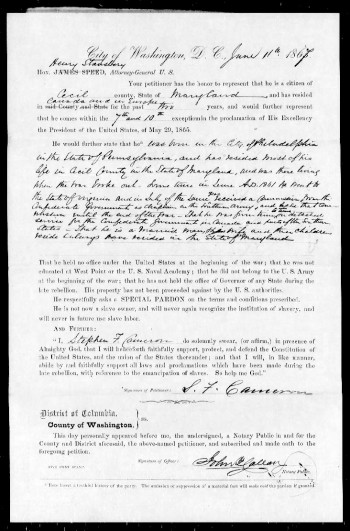

CAMMEYER (or CAMEYER), CORNELIUS (or CORNEL) B. (1839-1906). Private, 71st Regiment, Pennsylvania Infantry, Company H. Cammeyer was born in New York. As per his biography in John W. Black’s Carte de Visite collection at the Massachusetts Historical Society, Cammeyer was a comic opera singer known as Neil Gray in New York City minstrel shows before he volunteered for service in the Civil War. (Minstrel shows, which were popular from the mid-19th century well into the 20th century, had white performers depicting “blackness” by wearing exaggerated costumes and blackface make-up, supposedly for comedic effect, but relying on racist derision and stereotyping at its core.) His soldier record notes that he enlisted as a private at Fort Schuyler, New York, on June 28, 1861, and mustered into Company H of the 71st Pennsylvania, also known as the 1st California Regiment. The aforementioned biographical sketch reports that he was a private in a California [a town in Pennsylvania, near Pittsburgh] regiment and was captured in battle with other Pennsylvanians and imprisoned in Richmond, Virginia. Apparently, the California Brigade lost heavily at the Battle of Ball’s Bluff and the four commands of Colonel Edward D. Baker, who died in that battle, were designated as the 69th, 71st, 72nd, and 106th Regiments and known familiarly as the Philadelphia Brigade. Cammeyer was released after several months and mustered out with his regiment in May 1862.
Cammeyer then worked as a singer at Barnum’s Museum and as an actor on Broadway performing alongside Edwin Booth, the brother of President Abraham Lincoln’s assassin, John Wilkes Booth, Charlotte Cushman and other stars. According to the 1880 census, which listed him as Cornel Cameyer, he lived with his brother-in-law’s family at 1012 Third Avenue in Manhattan, was single and was an actor. At the time of the 1890 census, he lived at 310 East 63rd Street in New York City. The 1900 census reports that he was single, an actor (unemployed for the previous four months), could read and write and lived at 83 East 1st Street in Manhattan. He died after suffering a stroke. Section 168, lot 14789.

Cammeyer, dressed in a greatcoat, far left, and in civilian clothes with a cigar smoking pal, right.
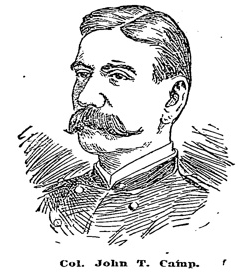
CAMP, JOHN T. (1839-1921). First lieutenant, 22nd Regiment, New York State National Guard, Company B. Born in Massachusetts, he enlisted and mustered into the 22nd New York National Guard as a first sergeant at New York City on May 28, 1862, was promoted to sergeant major and transferred to the Field and Staff on June 13, and mustered out after three months on September 5 at New York City. He re-enlisted on June 18, 1863, and mustered into the same regiment and company. Camp was promoted to first lieutenant on June 27, 1863, and mustered out at New York City on July 24.
Camp remained with the 22nd after the Civil War and became a captain on March 25, 1867; major on February 11, 1869; and lieutenant colonel on October 11, 1869. After his discharge on February 28, 1871, he was re-elected lieutenant colonel on December 22, 1873, colonel on January 18, 1888, and resigned on April 14, 1896, an occasion that was featured in The New York Times.
A merchant in civilian life according to the census of 1880, Camp was a manufacturer’s merchant according to the 1900 census. By 1910, he was a purveyor of dry goods and in 1920, was a food merchant. In 1905, he applied for and was granted an invalid pension, certificate 1,109,255. A member of the James Monroe Post #607 of the G.A.R., his last residence was on University Avenue in the Bronx. He died from heart disease. Section 45, lot 9613.
CAMPBELL, AUGUSTUS S. (1819-1867). Surgeon, 40th New York Infantry; assistant surgeon, 77th New York Infantry; 148th New York Infantry. A native of New York, Campbell enlisted as an assistant surgeon on February 3, 1862, and was commissioned into the Field and Staff of the 77th New York on February 15. After his discharge on February 9, 1863, he re-enlisted and was commissioned into the Field and Staff of the 148th New York on May 8, 1863. Upon his promotion to surgeon on September 1, 1863, he transferred into the Field and Staff of the 40th New York Infantry and was discharged for disability on June 9, 1864. He last lived in Savannah, Georgia, where he died from consumption. Originally buried in Philadelphia, Pennsylvania, his remains were removed and re-interred at Green-Wood on May 23, 1888. Section 35, lot 1089.
CAMPBELL, DAVID (1838-1897). Master ship mechanic, Port Royal Navy Yard. Born in Rochester, New York, he was one of the principal ship repairers for the Union Navy at Port Royal. After the War, he worked for several years as master mechanic at the Brooklyn Navy Yard and after that was Superintendent of the Columbia Iron Works for twenty years. At the time of his death, he was employed by E. W. Bliss and Company (see). Campbell last resided at 47 South Elliott Place, Brooklyn. He died from heart disease. Section 204, lot 29667, grave 2.
CAMPBELL, JAMES (1849-1926). Private, 84th Regiment, New York State National Guard, Company G. A New York City native, Campbell served as a private for 30 days with the 84th National Guard in 1863, and again from July 12-October 29, 1864. The Veterans Schedule of 1890 confirms his military duty. According to the census of 1900, he was a truck driver; in 1910, he was the proprietor of a trucking company. In 1908, he applied for and received a pension, certificate 1,146,493. His last residence was 507 West 158th Street in Manhattan. Soon after his death in 1926, his wife applied for and was granted a widow’s pension, certificate a-6-27-27. Section 180, lot 13379.
CAMPBELL, JOHNSTON (1826-1870). Private, 22nd Regiment, New York State National Guard, Company H. A native of New York City, Campbell enlisted there on May 28, 1862, mustered immediately into the 22nd Regiment, and mustered out three months later on September 5 at New York City. He last lived in the Tremont section of New York City. His death was attributed to consumption. Section 22, lot 6873.
CAMPBELL, SAMUEL J. (1840-1912). Private, 12th Regiment, New York State Militia, Company B. Campbell was born in Somerset, Pennsylvania. After he enlisted as a private at New York City on April 19, 1861, he served for three months in the 12th Regiment, mustering out on August 12.
Census records from 1870 indicate that he was a clerk for a United States appraiser; in 1880, he was working as a police detective, a promotion after years of work as a police officer. He is also listed as a police officer in the New York City Directories for 1875-1876 and 1876-1878 and the Brooklyn Directory for 1885-1886. The Veterans Schedule of 1890 confirms his military duty. In 1890, he successfully applied for and received an invalid pension, certificate 729,364. The New York City Directory for 1891-1892 lists him as a detective. According to the census of 1910, he was employed as a clerk for a printer.
As per his obituaries in The New York Herald and the Brooklyn Daily Eagle, he was a Freemason and member of the Royal Arcanum; comrades from both organizations were invited to attend his funeral. His last residence was 120 6th Street in Elmhurst, New York. His local newspaper, the Newtown Register, reports that he died very suddenly from heart trouble. A widower, he was survived by four daughters. Section 192, lot 23628, grave 3.
CAMPBELL, THOMAS (1830-1896). Private, 1st Dragoons, United States Army, Company H. Originally from Ireland, Campbell served as a private in the 1st Dragoons, United States Army. Other details are unknown. His last residence was 695 Ninth Avenue in Manhattan. Campbell’s cause of death was attributed to insolation (sun stroke). Section 204, lot 28925, grave 2.
CAMPBELL, WILLIAM H. (1841-1864). Private, 139th New York Infantry, Company D. Campbell enlisted at Brooklyn on August 27, 1862, and mustered into the 139th New York on September 9. After being severely wounded in his left leg at the Battle of Cold Harbor, Virginia, on June 3, 1864, he succumbed on January 24, 1864, at Washington, D.C. Section 188, lot 15815.
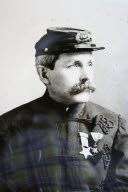
CANFIELD, CHARLES T. (1841-1915). Private, 4th New York Cavalry, Company G. A native of New York City, Canfield enlisted and mustered into the 4th New York Cavalry on November 13, 1861. He mustered out three years later on November 16, 1864, at Winchester, Virginia. In 1889, his application for an invalid pension was granted, certificate 1,o83,847.
For forty-eight years, he was associated with the Remington Arms Company and the Union Metallic Cartridge Company at 29 Warren Street in Manhattan as a forwarding agent (transporter of freight). As per the New York City Directory for 1877, he was a cartman; at that time, he lived at 303 West 4th Street. In 1880, his occupation was listed as carman. An article in the Brooklyn Daily Eagle about an arrest on February 4, 1898, quotes Canfield who was the boss truckman for Hartley & Graham, a firearms dealer, as reporting the theft of $140 worth of revolvers and cartridges from their stable on 620 West 44th Street in Manhattan.
According to the censuses of 1900 and 1910, Canfield was employed as a truckman. A member of the Lafayette Post #140 of the G.A.R., he also belonged to and was treasurer of the New York Team Owners Association, the Freemasons, and the Standard Council of the Royal Arcanum. He last lived at 9 West 91st Street in Manhattan. Elizabeth Canfield, who is interred with him, received a widow’s pension in 1915, certificate 798,662. Section 186, lot 21108.
CANFIELD, MICHAEL (1832-1889). Adjutant and first lieutenant, 1st New York Light Artillery, Battery E. A native of Poultney, Vermont, Canfield studied law in Rochester, New York. He enlisted there as a private on August 17, 1861, and mustered into the 1st Light Artillery ten days later. On January 27, 1864, he was promoted to sergeant-major and mustered in as a second lieutenant October 12, 1864. He was promoted to first lieutenant on March 9, 1865, and was named acting adjutant on March 31, 1865. He mustered out with his regiment on June 21, 1865 at Elmira, New York. He fought with the Army of the Potomac and according to his obituary in The New York Times, “He put in the last battery at Appomattox before the surrender of Gen. Lee.”
After the Civil War, Canfield was a prominent lawyer in New York City, who argued cases before the State Court of Appeals, and was an attorney for the American Mercantile and Collection Association. He is listed as a lawyer in the New York City Directories for 1877 and 1882-1883; in 1877, his office was on Cedar Street and in 1883, his firm was at 234 Broadway. In addition, he was a member of the Lafayette Post #140 of the G.A.R. He last lived at 153 West 11th Street in New York City. The cause of his death was pneumonia. Matilda Canfield applied for and was granted a widow’s pension in 1911, certificate 749,175. Section F, lot 18613.
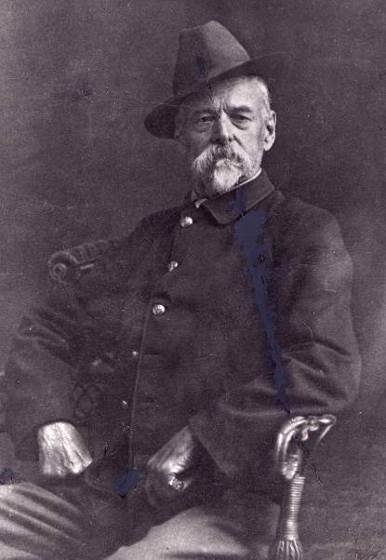
CANN, BALDWIN (1837-1920). First lieutenant, 4th New York Cavalry, Company A; sergeant, 84th New York (14th Brooklyn) Infantry, Company B. Born in New York City, he was educated at the Broome Street public school and at the Cooper Institute. He married Elizabeth Moffett in 1856. In 1860, his occupation was listed as artist on the census. He is listed as a silversmith in the Brooklyn Directory for 1867-1862. He was 5′ 6″ tall with a light complexion, brown hair and blue eyes.
Known by his nickname, “Baldy,” he enlisted as a private on April 18, 1861, mustered into the 14th on May 23, was promoted to sergeant, fought at Bull Run, Virginia, and was later reduced to ranks. He re-enlisted on December 29, 1863, and was discharged for promotion to first lieutenant on February 13, 1864, effective upon his transfer into the 4th New York Cavalry, Company A, on that date. He mustered out on September 23, 1864, at Harper’s Ferry, West Virginia, although his soldier record indicates that he was “retained in the field” after he mustered out. According to his obituary in the Brooklyn Daily Eagle, he was wounded three times by saber cuts to his legs during battle and also sustained a bullet wound to his arm.
Cann is listed as a silver chaser (one who puts decorative work on silver) in the Brooklyn Directory for 1866 and as a silversmith in the Brooklyn Directory for 1867-1870. Census records from 1870 indicate that Cann was a silversmith, the same profession as his father; in 1880, he was a silver chaser (embosser). An expert craftsman, he was an engraver of gold and silver at Tiffany & Co. for 40 years. Remaining active in military affairs, he was a member of the War Veterans’ Union Club, was involved in organizing a convention of Civil War soldiers who lived in Brooklyn in 1876, and belonged to the William Rankin Post #10 of the G.A.R. An article about him appeared in The New York Times on October 8, 1887, when he was accused of striking a fellow employee at Tiffany’s in the mouth. Their dispute was traced to Cann’s leaving the Knights of Labor after opposing their policy on apprenticeship at the workplace, which he considered un-American, and his working through a lock-out. Cann supported the Knights’ original demands for increased salary rather than payment for piecework but claimed that he was persecuted after he severed his ties with the union. He was granted an invalid pension in 1889, certificate number 690,949. The Veterans Schedule of 1890 confirms his military service. He is listed as a chaser in the Brooklyn Directory for 1896-1898.
In 1906, an article about his 50th wedding anniversary celebration was highlighted in the Brooklyn Daily Eagle including his declaration that he felt as young as when he enrolled in the 14th for the Civil War. The censuses of 1900 and 1910 show that he was still employed as a silversmith; his wife died in 1908. On May 19, 1911, an article in the Brooklyn Daily Eagle listed Cann as among those living members of the 14th New York who were honored at a dinner at the 14th’s Armory on the 50th Anniversary of going to the front in the Civil War; 91 veterans were saluted by 500 diners. After his retirement, he lived at the National Soldiers’ Home in Hampton, Virginia. By 1920, he was living at the Soldiers’ Home in Bath, New York. (He had also been a patient at the Soldiers’ Home in Hampton, Virginia.) His paperwork for the Soldiers’ Home notes that he suffered a gunshot wound to the left knee resulting in deformity, chronic rheumatism, cardiac hypertrophy and loss of teeth. He died at the home of his granddaughter at 1249 Sterling Place in Brooklyn. A widower at the time of his death, all of his five children pre-deceased him, including a daughter who died as an infant in 1868 and two sons who died in their teens. In 2007, his 1861 Springfield rifle-musket was sold at auction. Section 58, lot 9674.

CANN (or CAMM), EDWARD (1844-1862). Private, 5th New York Cavalry, Company B. Born in New York, he enlisted at New York City as a private on August 21, 1861, and mustered into the 5th Cavalry that day. He died of typhoid fever at Alexandria, Virginia, on or about September 15, 1862. His mother, Mary Cann, applied for and was granted a pension on May 18, 1863, certificate number 6392. Section 147, lot 22043.
CANN, GEORGE R. (1842-1870). Private, 150th New York Infantry, Company H. Born in Boston, Massachusetts, Cann enlisted at Fishkill, New York, as a private. The date of his enrollment and the regiment and company in which he served for his first tour of duty are unspecified. He was hospitalized for disability on January 11, 1863, at an Army General Hospital in Savannah, Georgia. Army records show that he was moved to the Soldiers’ Depot in New York City on January 31, 1863. He re-enlisted as a private and served in Company H of the 150th New York. Further details of that service are unknown. His last residence was 244 East 21st Street, New York City. Cann died from tuberculosis. Section 147, lot 22043.
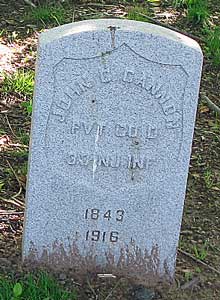
CANNON, JOHN C. (1843-1916). Private, 12th Regiment, New York State National Guard, Company I; 33rd New Jersey Infantry, Company D. A native New Yorker, Cannon enlisted there in 1862 and served with the 12th Regiment’s National Guard when it was activated for three months in 1862. He re-enlisted as a private on August 20, 1863, mustered into the 33rd New Jersey on September 4, and mustered out on July 17, 1865, at Washington, D.C.
In 1896, his application for an invalid pension was granted, certificate 933,529. He was living at 466 West 165th Street in Manhattan. He died from heart disease. Frances Cannon’s application for a widow’s pension was granted in 1916, certificate 814,574. Section 3, lot 8368.
CANTRELL, JOHN P. (1836-1901). Private, 47th New York Infantry, Company K. After enlisting at New York City on September 6, 1861, he mustered into the 47th eight days later, and was discharged at the end of his term. He re-enlisted on February 29, 1864, and served with the same regiment until he mustered out on August 30, 1865, at Raleigh, North Carolina. He last resided at 600 Wales Avenue, New York City. Cantrell died from apoplexy. Section 55, lot 7149, grave 516.
CANTRELL (or CANTRELLE), JOSEPH (1844-1909). First lieutenant, 80th United States Colored Troops, Companies C and H; private, 7th Regiment, New York State National Guard, Company D. A native New Yorker and a wheelwright by trade, he was 5′ 8″ with blue eyes, auburn hair and a light complexion. Cantrell first served in the 7th Regiment when it was activated in 1862 from May 25-September 5. He then mustered into Company C of the 80th Regiment of the United States Colored Troops (USCT), also known as the 8th Regiment of the Corps D’Afrique, as a second lieutenant on February 26, 1863. Stationed at Port Hudson and Baton Rouge, Louisiana, he was on duty for a short time during the siege of the former. After a promotion to first lieutenant on December 15, 1863, he was transferred into Company H on January 1, 1864, and honorably discharged on February 5, 1864, at New Orleans.
After the war, he lived in New York City, then moved to Kings Park, Long Island, in 1879 where he lived for 10 years before relocating to his last residence in Huntington, New York. In 1908, his application for an invalid pension was granted, certificate 1,180,171. Cantrell died from pneumonia. Mary J. Cantrell, who is interred with him, applied for and received a widow’s pension in 1909, certificate 702,664. His name is displayed on the African American Civil War Memorial in Washington, D.C., plaque C-86. Section 13, lot 10430.
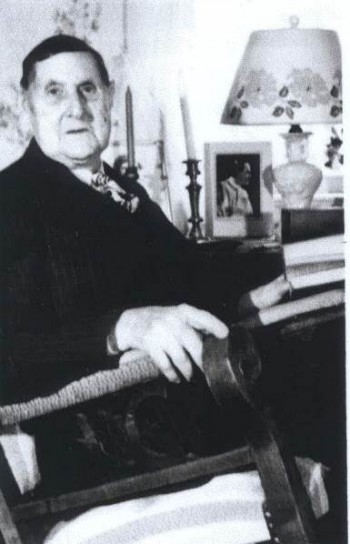
CANTUS, HENRY (1846-1899). Private, 18th New York Cavalry, Company C. Originally from Frankfurt, Germany, he enlisted at New York City as a private on December 30, 1864, mustered on that day into Company C of the 18th New York Cavalry, and mustered out on May 31, 1866, at Victoria, Texas. In 1890, he applied for an invalid pension, certificate number 899,051. He last lived at 306 West 13th Street in New York City. He died from heart disease. Sarah Cantus’s application for a widow’s pension was granted in 1900, certificate 513,454. Section 135, lot 30010, grave 497.
CANTY, JOHN (1829-1906). First lieutenant, 63rd New York Infantry, Company G. A native of England, he enlisted on September 13, 1861, at New York City, was commissioned in on September 24, and was discharged on December 6 of that year. A cooper by trade, his last residence was at 47 Fourth Avenue in Brooklyn. He died from nephritis. Section 135, lot 27263, grave 2015.
CAREY, PETER (1826-1869). Sergeant, 145th New York Infantry, Company I; private, 107th New York Infantry, Company F. Born in Ireland, he came to the United States in 1856. Carey enlisted as a sergeant at New York City on July 25, 1862, mustered into the 145th New York on September 11, and transferred out on December 9, 1863, After being reduced to the rank of private on January 12, 1864, he transferred that day into the 107th New York. At some point, he was at Stones Hospital in Washington, D.C., and was listed as absent and sick when his company mustered out at the nation’s capital on June 5, 1865. He last lived at 210 Fifth Avenue in New York City. Carey died from tuberculosis. Section 122, lot 17806, grave 175.
CARL (or KARLE, KARL), JACOB (1817-1865). Private, 175th New York Infantry, Companies H and B. Originally from Germany, he was borne on the rolls as Jacob Karl. After enlisting as a private at New York City on September 25, 1862, he mustered into Company H of the 175th New York on January 17, 1863. Subsequently, he transferred intra-regimentally to Company B on October 17, 1863, and was discharged for disability at New York City on an unknown date. Carl last lived at 133 Pitt Street in Manhattan. He died from diarrhea. Section 117/122, lot 10975, grave 567.
CARLETON, ISAAC S. (1830-1876). Private, 22nd Regiment, New York State National Guard, Company D. A native of New York City, Carleton served for 30 days in the 22nd New York National Guard in 1863. He last lived at 273 West 40th Street in Manhattan. His death was attributed to paralysis. Section 102, lot 3442.
CARLTON (or CARLETON, CARELTON), FREDERICK HOTCHKISS (or F. H.) (1844-1913). Drummer, 22nd Regiment, New York State National Guard, Company C; private, 9th New York Heavy Artillery, Company L; 2nd New York Light Artillery, Company L. New York City-born Carlton enlisted at New York City as a musician on May 28, 1862, mustered into the 22nd Regiment that day, and mustered out at New York City on September 5. He then returned to the 22nd for 30 days as a drummer in 1863. He re-enlisted as a private at Syracuse, New York, on November 30, 1863, and mustered into the 9th New York Heavy Artillery on December 2. After he was taken as a prisoner of war on September 28, 1864, at an unstated place, he was paroled two days later. Carlton was transferred into the 2nd New York Light Artillery on June 27, 1865, from which he mustered out on an unknown date.
In 1905, he received a pension under certificate 1,142,577. In 1908, he was living in Jamaica, New York, and was employed as a laborer. He then resided in at the Soldiers’ Home in Bath, New York, and was living there according to the 1910 census. Carlton died from an esophageal obstruction. Section 102, lot 3442, graves 1 and 2.

CARLTON, NATHANIEL E. (1839-1863). Sergeant, 84th New York (14th Brooklyn) Infantry, Company E. A resident of Hudson Avenue in Brooklyn, he enlisted as a private on April 18, 1861, and mustered in on May 23. In a Letter to the Editor of the Brooklyn Daily Eagle, published January 1, 1862, Carlton, then a corporal, defended the honor of two soldiers listed as deserters, stating that they were in fact serving their country, one performing his duties as a soldier, and the other, dying of brain fever in the brigade hospital.
Promoted during his service to sergeant, Carlton was mortally wounded by a gunshot to his left arm at the Railroad Cut at Gettysburg, Pennsylvania, on July 1, 1863. His arm was amputated and he died soon after on July 28. On September 3, 1863, he was interred in Green-Wood with ex-members of the regiment and those on furlough at attendance at his funeral. Charles Teasdale, a corporal of his company wrote, “Sergt. Nathaniel Carlton, shot through the arm and since died in hospital. Poor, dear, good Nat. Carlton and his presentment of coming evil told me by himself, was alas sadly verified. God comfort his poor widowed mother and may she and her splendid son enjoy eternal happiness above where war and death is not.” Section 115, lot 13536 (Soldiers’ Lot), grave 71.

CARMAN, BENJAMIN H. (1816-1903). Corporal, 48th New York Infantry, Companies B and H. Carman is listed as a shoemaker in the Brooklyn Directory for 1857-1862.After enlisting at Brooklyn as a private on September 5, 1861, he mustered immediately into Company B of the 48th New York. During his service, he was wounded at Chester Hill, Virginia, on May 7, 1864, promoted to corporal on January 2, 1865, transferred to Company H on an unstated date, and discharged for disability on July 10, 1865.
Carman is listed as a shoemaker in the Brooklyn Directories for 1865, 1868 and 1870-1873. He was granted an invalid pension in 1871, certificate 116,061. As per the Brooklyn Directories for 1873-1876 and 1890-1892, he was still working as a shoemaker. He last lived at 96 Pine Street in Brooklyn. The cause of his death was nephritis. Section 176, lot 18189. Section 176, lot 18189.

CARMAN, FRANKLYN (or FRANKLIN) D. (or B., O.) (1847-1900). Private, 8th New York Cavalry, Company L. After enlisting at New York City, his birthplace, on February 25, 1865, Carman mustered immediately into the 8th New York Cavalry, and mustered out of service on June 27, 1865, at Alexandria, Virginia. His pension application notes that he served as a bugler in Company K of the 8th Cavalry in 1864, but lists no specific dates.
In civilian life, he was employed as a buyer. In 1895, he applied for a pension application number 1,163,798, but no certificate number is given. His last address was 343 West 32nd Street, Manhattan. Carman died from tuberculosis. After his death in 1900, Annie S. Carman applied for and received a widow’s pension, certificate 519,546. Section 63, lot 7218.

CARMAN, THOMAS (1824-1899). Private, 61st New York Infantry, Companies E and H. Born in New Jersey, Carman was employed as a cartman according to the censuses of 1850 and 1860. He enlisted on October 10, 1861, at New York City, mustered into Company E of the 61st New York two days later, and transferred into Company H on November 1 of that year. He was discharged for disability on September 6, 1862, at New York.
In civilian life, the 1870 census indicates that Carman returned to work as a cartman. He last lived at 57 Tompkins Avenue, New York City. His death was attributed to Bright’s disease. Section 161, lot 9769, graves 7 and 12.
CARMICHAEL, JAMES W. (1843-1879). Second lieutenant, 37th Regiment, New York State National Guard, Company B. Born in Jersey City, New Jersey, he enlisted as a sergeant at New York City on May 29, 1862, mustered into Company B of the 37th Regiment that day, and mustered out on September 2 at New York City. When his unit was reactivated a year later on June 24, 1863, he returned to the same regiment and company with a promotion to first sergeant and served for 30 days. On May 6, 1864, he was promoted to second lieutenant, commissioned into the same company, served for 30 days, and mustered out on June 6, 1864, at Staten Island. He last resided in Orange, New Jersey. He died from tuberculosis. Anna Carmichael applied for and received a widow’s pension in 1893, certificate 391,206.Section 171, lot 12600.

CARMIENCKE (or CARMRICK), JOHN H. (1847-1903). Private, 96th New York Infantry, Company H. Originally from Copenhagen, Denmark, he was the son of Johann Herman Carmiencke, a Hudson River painter who came to the United States in 1851. Carmiencke enlisted as a private at New York City, where he resided, on April 5, 1865, and mustered into the 96th New York. He was 5′ 10″ tall with brown eyes and dark hair and complexion. On January 24, 1866, he mustered out at Richmond, Virginia.
As per the New York City Directory for 1895-1896, Carmiencke was a public accountant who lived at 412 West 23rd Street. In 1897, he applied for an invalid pension, citing rheumatism, application 1,189,374. Carmiencke last lived at 412 West 23rd Street in Manhattan. He succumbed to heart disease. Section 126, lot 27263, grave 759.
CARNES, GEORGE W. (1842-1869). Private, 11th New York Infantry, Company K. On April 20, 1861, Carnes, a native New Yorker, enlisted at New York City as a private. On May 7, he mustered into the 11th New York Infantry where he served until he mustered out on June 2, 1862, at New York City. He last resided at 133 Mercer Street in Jersey City, New Jersey. Carnes died from Bright’s disease. Section 162, lot 15215.
CARNES, LEWIS M. (1837-1893). First sergeant, 7th Regiment, New York State National Guard, Company F. Carnes was born in Poughkeepsie, New York. Serving for three months with the 7th Regiment, Carnes enlisted as a first sergeant on May 25, 1862, mustered in that day, and mustered out at New York City on September 5. After the War, he was a member of the G.A.R. According to the 1880 census, he was listed as working in the mining office. A widower, he last lived at 21 West 19th Street, New York City. He died from pneumonia. Section 99, lot 15075.
CARNIAUX, CHARLES J. (1844-1889). Landsman, United States Navy. A New York State native, Carniaux was a landsman aboard the USS North Carolina and the USS Niagara during the Civil War. As per the census of 1880, he was listed as a postal clerk in New York City. He last lived at 216 Willow Avenue in Hoboken, New Jersey. His death was caused by a hemorrhage. In 1890, Frances Carniaux, who is interred with him, applied for and received a widow’s pension from the Navy under certificate 4,692. Section 64, lot 4071, grave 544.
CARPENTER, JAMES H. (1841-1894). Corporal, 22nd Regiment, New York State National Guard, Company F; private, 83rd New York Infantry, Company G. He enlisted as a private at New York City on June 20, 1861, mustered into the 83rd six days later, and was discharged for disability at Martinsburg, West Virginia, on July 21, 1861. He re-enlisted at New York City as a corporal on May 28, 1862, mustered into the 22nd Regiment on the same day, and mustered out with his company after serving for three months on September 5 at New York City.
In civilian life, Carpenter was employed as a car driver. In 1891, he applied for an invalid pension in 1891, application 2,041,043, but no certificate number is given. Carpenter last lived at 360a Tompkins Avenue in Brooklyn. His death was attributed to paralysis. Section 156, lot 24352.
CARR, CHARLES H. (1837-1862). Sergeant, 5th New York Infantry, Company D. A carpenter by trade, Carr was 5′ 11″ tall with gray eyes and dark hair. He enlisted at New York City, his birthplace, on April 25, 1861, mustered in as a private on May 9, and was promoted to sergeant on September 20 of that year. After contracting typhoid fever in May of 1862, he returned home to New York City where the disease claimed his life on July 23. A pension was granted to his mother, Sarah P. Carr, certificate 238,004. Section 69, lot 11783.
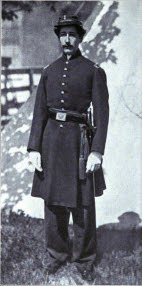
CARR, GOUVERNEUR (1839-1889). Colonel by brevet; lieutenant colonel, 165th New York Infantry; captain, 5th New York Infantry, Company B. Born in New York City, he was 5′ 10″ with blue eyes and brown hair. A graduate of the City University, he spoke at the 1855 graduation on “Obedience to the Law.” In October, 1860, he served as an aid to the general marshal of the Wide Awake demonstration, on behalf of Republican candidate Abraham Lincoln, in New York City.
Carr was employed by the editorial department of The New York Times when he enlisted at New York City as a first lieutenant on April 25, 1861. On May 9, he was commissioned into the 5th New York and was promoted to captain on September 3 of that year. He was involved in opening recruiting stations in New York City until he was discharged for promotion on September 30, 1862, the same day that he was commissioned into the 165th as major of the Second Battalion at Albany, New York, and subsequently commanded it as lieutenant colonel as of July 25, 1863. He was severely wounded in the right thigh at the siege of Port Hudson, Louisiana, on May 27, 1863, and suffered an injury to the right wrist at Sabine Cross Roads, Louisiana, on April 8, 1864. Brevetted colonel for meritorious service, he was dismissed on August 30, 1865; that dismissal was revoked and he was honorably discharged on September 1, 1865, at Charleston, South Carolina.
The New York Directory for 1875-1876 lists Carr as an editor working at 34 Park Row. Retaining his interest in military affairs, he was active in the National Guard, became editor of the Guardsman in 1884 (a new journal to “publish the movements of organizations in the National Guard” and “special articles of interest to soldiers”), and was a reporter with the City Desk of The Tribune. His last residence was at 115 East 14th Street in New York City. He died from heart disease. Anna Carr, his wife, received a widow’s pension, certificate 428,110. Section 77, lot 4991.
CARR, WILLIAM SEGGIE (1830-1880). Colonel, 8th Regiment, New York State National Guard, Companies G and E. As per his obituary in The New York Times, he was born in Dundee, Scotland, and immigrated to the United States when he was “quite a lad.” Beginning his commitment to military affairs in 1850, he enlisted in the 6th Regiment’s “Governor’s Guard” and was appointed sergeant major of the 8th Regiment, also known as the “First German Rifles,” six years later. In 1858, he was promoted to lieutenant of Company H of the 8th Regiment and participated that year in the quarantine or “Sepoy” riots, a series of violent attacks by residents of Staten Island on the New York Marine Hospital, the largest quarantine facility in the United States.
In early 1861, he organized a new company, designated Company G, and went to Annapolis, Maryland, when the 8th Regiment was called to serve in the Civil War. As per soldier records, Carr enlisted as a captain at New York City on April 23, 1861, and was commissioned into the 8th Regiment’s Company G two days later. His New York Times obituary states that during the Battle of Bull Run, Virginia, Carr rallied his men when his unit was demoralized and saved the regimental colors from capture. He mustered out on August 2 at New York City. The obituary goes on to report that after returning to New York City, William was elected captain of Company E and that his company presented him with a silver and gold mounted dress sword. When the 8th returned to service a year later, he was commissioned into Company E and mustered out at New York City on September 10, 1862. Carr returned to Company E when he was commissioned on June 17, 1863 and mustered out after 30 days at New York City on July 23. He was promoted to major in 1864 and was named colonel in the fall of 1865. Upon assuming that position, he took his regiment out for an exhibition drill in Tompkins Square. He remained an active member of his unit until his resignation in 1870.
His first marriage was to Sarah Clock in Manhattan. They had a son, William Leman Carr, who was baptized at St. Andrew’s Church; that baptism is documented in the Church Records of the Episcopal Diocese of New York. According to the Find A Grave website, Sarah died in 1870. Another son, Abbott Carr, was born and died in 1870. Carr is listed in the 1870 census as a forty-year-old plumber living in Manhattan. His sons, William (age 10) and Abbot (one month old), and Charlotte Carr (age 12), listed as his inferred daughter, are included in that census. No wife is listed; Sarah apparently had died before the census was taken. Two Irish-born servants complete the household. Carr had $35,000 in personal estate and $30,000 in real estate- quite a bit of wealth at that time.
After Carr resigned from the 8th Regiment in 1870, he became a member of its Veteran Corps and was elected president of that organization in 1878. His second marriage to Clara Elizabeth Wise took place in Manhattan on April 11, 1871. As per the 1880 census, William and Clara lived at 25 East 132nd Street in Harlem with children Ella (21) and William (19). His sister-in-law, Sarah Wise, also lived in the household. Carr was in the plumbing materials business.
In addition to his membership the Veteran Corps, Carr was a life member of the National Rifle Association dating to that organization’s early history. A senior partner in the plumbing firm of William S. Carr & Company, he was the inventor of many products used in the trade. An autographed paper of his was sold on eBay in July 2023; that listing notes that he was proprietor of an extensive plumbing iron foundry on the Harlem River and had received patents for water closet toilet inventions and improvements. The aforementioned document for sale was an accounting of expenses for an 8th Regiment event at the Brooklyn Academy of Music on February 25, 1865. The autographed paper sold for $19.99.
As per his obituary in The New York Times, Carr last lived at 25 East 138th Street in Manhattan, apparently one of his real estate holdings. As per his obituary, he had been bedridden for the last five weeks of his life, suffering from consumption (tuberculosis). William had caught a cold while riding in an elevated railroad car two years prior to his death, then developed pneumonia and ultimately consumption. Carr’s death was also announced in the Brooklyn Union which confirms that he was a colonel in the Veteran Association of the Eighth Regiment, New York National Guard. He was survived by his second wife, son and daughter (whose name appeared on censuses as Charlotte and Ella). The members the military associations to which he belonged attended his funeral in civilian attire.
As per his last will and testament in probate records, he left his wife, named Carolina M. Carr in the document, a home at 61 West 128th Street, for her lifetime. He also gave her $3,000 and all the furnishings therein, to be sold by the executors after her death. He gave his nephew, John Carr who lived in Kansas, $500. He directed the executors to sell his other properties eighteen months after his death. In addition to some money going to the executors, he promised money for the education of Elizabeth Johnson (unknown relationship) and the future children of John Carr, provided they do not become drunkards or develop other unsavory character traits. Section 49, lot 13247.
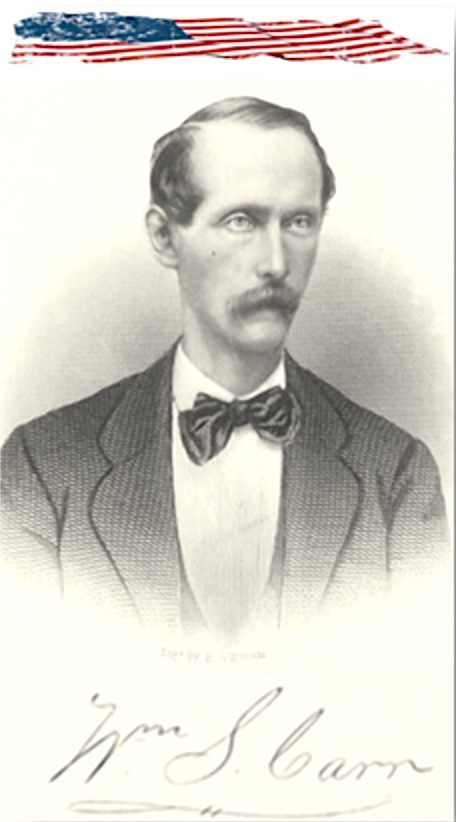
CARRINGTON, WILLIAM (1831-1862). First sergeant, 51st New York Infantry, Company E. A native New Yorker and a resident of Charles Street in Manhattan, he enlisted at New York City as a first sergeant on August 19, 1861, and mustered into the 51st on September 9. On March 14, 1862, he was severely wounded in the left leg at New Berne, North Carolina, and succumbed to that injury at his home at 119½ Charles Street in Manhattan on May 9, 1862. Section B, lot 9895, grave 375.
CARROLL, JAMES (1835-1907). Private, Marine Corps, United States Navy. Born in Ireland, Carroll was 5′ 6″ tall, weighed 130 pounds, had sandy hair, blue eyes, and a light complexion. A resident of Deer Park, Long Island, he enlisted on August 18, 1862, at Huntington, Long Island, and was a farmer by trade. He served as a Marine Corps private on the USS Octoroon after enlisting on January 25, 1862. On June 30, 1865, he was discharged at Charleston, South Carolina.
After his service, Carroll returned to Deer Park and then lived in Brooklyn from 1876 until 1894 when he took up residence at the New York Soldiers’ and Sailors’ Home. In 1892, he was awarded a pension which was updated in 1904, certificate 34,819. According to his obituary, he was a well-known resident of the Twentieth Ward who last resided at 117 Carlton Avenue, Brooklyn. After his death from a cerebral hemorrhage in 1907, his widow, Bridget Carroll, received a pension from the Navy, certificate 20,439. Section 2, lot 5499, grave 1368.
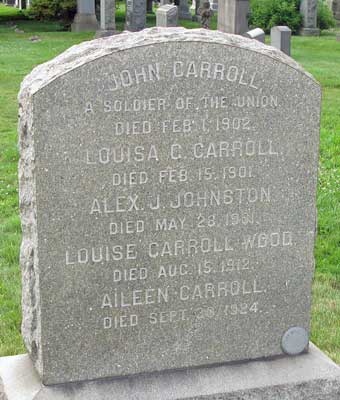
CARROLL, JOHN (1842-1902). Private, 75th New York Infantry, Company C. Born in Hudson, New York, he enlisted as a private at Skaneateles, New York, on September 21, 1861, and mustered into the 75th New York on November 26. He was wounded at the Battle of Port Hudson, Louisiana, on June 23, 1863, and discharged for disability on February 17, 1864, at Elmira, New York. On March 17, 1864, he applied for an invalid pension that was granted under certificate 44,389.
According to the census of 1900, Carroll was living at 334 President Street in Brooklyn and was employed as an inspector. His gravestone is inscribed, “A Soldier of the Union.” His last residence was 178 Prospect Park West in Brooklyn. Carroll died from a cerebral hemorrhage. Section 205, lot 31308, grave 1.
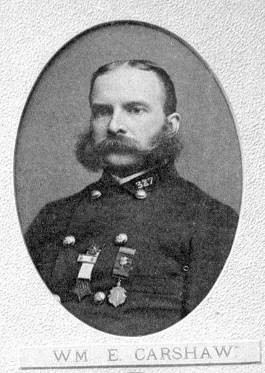
CARSHAW (or KERSHAW), WILLIAM E. (or A.) (1842-1902). Private, 84th New York (14th Brooklyn) Infantry, Company E. Born in Brooklyn, and employed in the law office of Judge John Dakerman, he enlisted as a private at Brooklyn on April 18, 1861, and mustered in on April 23. He participated in many engagements with the 14th Brooklyn including: Bull Run, Virginia; South Mountain and Antietam, Maryland; Rappahannock Station, Groveton, Fredericksburg and Chancellorsville, Virginia; Port Royal, South Carolina; and Gettysburg, Pennsylvania. On July 1, 1863, at the Battle of Gettysburg, he was wounded by a shell, leading to amputation of his left leg, and was honorably discharged for disability on November 12, 1863.
Carshaw was a charter member of Wadsworth Post #4 of the G.A.R., joining in 1866, and then helped start the Ulysses S. Grant Post #327, where he was chairman of the Board of Trustees. He is listed as a clerk in the Brooklyn Directories for 1866, 1870-1873 and 1873-1876; the latter two directories note that he lived at 101 Monroe Street. As per the Brooklyn Directory for 1876-1878, he was a clerk at the Customs House. An article in the Brooklyn Union-Argus on July 13, 1881, listed Carshaw as among the 700-800 veterans and families who participated in an excursion and picnic to Cold Spring Grove on Long Island Sound; the event was hosted by Rankin Post #10 of the G.A.R. He last resided at 101 Monroe Street in Brooklyn but died at the House of Relief in New York City. His death was attributed to a hemorrhage. Section 51, lot 12580.
CARSTANG, WILLIAM (1840-1894). Private, 12th Regiment, New York State Militia, Company B; 8th Regiment, New York State National Guard, Company G. Carstang, a native of New York City, enlisted as a private in 1861 and mustered into the 12th New York State Militia when it was activated for three months. He re-enlisted in 1863 and served for 30 days with the 8th Regiment’s National Guard.
Census records show that Carstang worked as a butcher in civilian life. He is cited as a butcher, working alongside his father, in the New York City Directory for 1876-1878; at that time, he worked at 51 Washington Market. He is also listed as a butcher at the same address in the Phillips’ Business Directory for 1881-1882. After he applied for an invalid pension in 1892, it was granted under certificate 827,952. He last lived at 902 8th Avenue in Manhattan. Julia Carstang applied for a widow’s pension after his death in 1894, application 601,079. Section 106, lot 11353, grave 2.
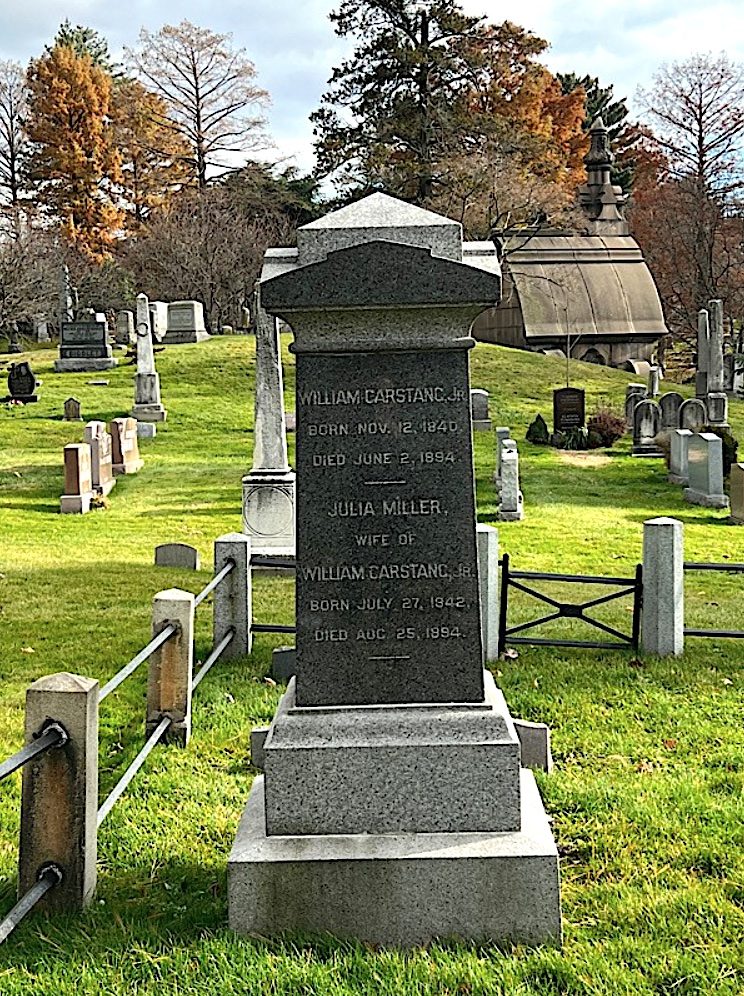
CARTER, HENRY C. (1841-1915). Second lieutenant, 1st New York Marine Light Artillery. A native New Yorker, he enlisted there on December 19, 1862, was commissioned into the 1st New York Light Artillery on December 27 but not assigned to a company, and was discharged on March 31, 1863, at New York City. After the War, his occupation was listed on census records as a lake captain/sailor. He last lived in Lakewood, Cuyahoga City, Ohio. His death was attributed to apoplexy. Section 113, lot 18623.
CARTER, ROBERT (1844-1880). Corporal, 13th Regiment, New York State National Guard, Company E. Born in Brooklyn, Carter enlisted there as a corporal on May 28, 1862, mustered into Company E of the 13th Regiment that same day, and mustered out of service three months later on September 12 at Brooklyn. In civilian life, he worked as a store clerk. He last lived at 46 Bedford Avenue in Brooklyn. His death was attributed to Bright’s disease. Section 27, lot 7074.
CARTER, THADDEUS (or THADEUS) WASHINGTON (1822-1889). Private, 47th Regiment, New York State National Guard, Company B. According to the United Methodist Church Records, Carter married Leah Smith, who is interred with him, on June 18, 1843. During the Civil War, Carter enlisted as a private at Brooklyn on May 27, 1862, and mustered immediately into Company B of the 47th Regiment. He mustered out with his company on September 1, 1862, at Brooklyn.
Carter is listed as a tailor in the 1863 Brooklyn Directory. At that time, he lived at 183 South 6th Street. The 1865 New York State census lists him as a tailor living in Brooklyn with his wife and extended family. He is also listed as a tailor in the 1866 Brooklyn Directory and as a cutter in the 1867-1870 Brooklyn Directory. The 1875 New York State census shows him still working as a tailor and living with his wife in Brooklyn. He last lived at 125 Sands Street in Brooklyn. His death was caused by phthisis. In 1890, Annie Carter, his second wife, applied for a widow’s pension, certificate 309,130. Section 79, lot 10656.
CARTER, WILLIAM A. (1840-1908). Corporal, 13th Regiment, New York State National Guard, Company B. A New York native, Carter enlisted at Brooklyn on May 28, 1862, as a corporal, and mustered into the 13th National Guard the same day. He served with the regiment until he mustered out at Brooklyn after three months on September 12. He applied for and was granted an invalid pension in 1890, certificate 1,111,611. He last lived in Lynbrook, Long Island. Carter’s death was caused by nephritis and heart failure. Section 27, lot 7074, grave 2.
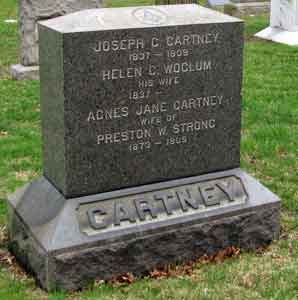
CARTNEY, JOSEPH G. (1837-1909). First lieutenant, 56th Regiment, New York State National Guard, Company A; private, 13th Regiment, New York State National Guard, Company D. Born in Philadelphia, Pennsylvania, and a carpenter by trade, Cartney enlisted and mustered into the 13th Regiment as a private at Brooklyn on May 28, 1862. He served with the 13th at Suffolk, Virginia, then mustered out in Brooklyn three months later, on September 12. Cartney was promoted to first lieutenant on August 2, 1864, the same day that he was commissioned into the 56th Regiment from which he mustered out at New York City after serving 100 days on November 6.
In civilian life, Cartney belonged to a Masonic lodge and was a master from 1897-1900. The sketchbook for his lodge states that he was a stair-builder who raised his company in the 56th Regiment. He is listed as a stair-builder in the Brooklyn Directories for 1866, 1867-1870 and 1873-1876; the 1880-1882 Brooklyn Directory identifies him as a carpenter. In 1897, he applied for and received an invalid pension, certificate 1,045,193.
As per his obituary in the Brooklyn Daily Eagle, he was a member of the 56th War Veterans Association; comrades were invited to attend his funeral. That newspaper also noted that members of his Masonic lodge were invited to attend a special tribute to him. His last residence was 454 56th Street in Brooklyn but he spent the end of his life at the Soldiers’ Home in Bath, New York. Shortly after his death from nephritis in 1909, Helen G. Cartney Woclum applied for and received a widow’s pension, certificate 694,289. Section 132, lot 33141, grave 1.
CARTWRIGHT, GEORGE (1841-1880). Color sergeant, 3rd United States Veteran Infantry, Company C; sergeant, 84th Regiment, New York State National Guard, Company B; private, 5th New York Infantry, Company G. Originally from Ireland, he came to the United States in 1851. Cartwright was 5′ 7½” with brown hair and eyes. A coach driver at the start of the Civil War, he enlisted as a private at Fort Schuyler, New York, on May 14, 1861, and mustered into the 5th on June 28. Cartwright was wounded in the right wrist at Gaines’ Mills, Virginia, on June 27, 1862, deserted on October 6 of that year, returned to service on May 7, 1863, and mustered out the next week on May 14 at New York City. He re-enlisted in the 84th Regiment, New York National Guard, serving as a sergeant from July 3 through August 6, 1863, and from July 12 through October 9, 1864. Subsequently, he was a color sergeant in the 3rd United States Veterans from March 1, 1865 through February 28, 1866. After the Civil War, he was employed as a painter and lived in Brooklyn. Section ? lot ?.
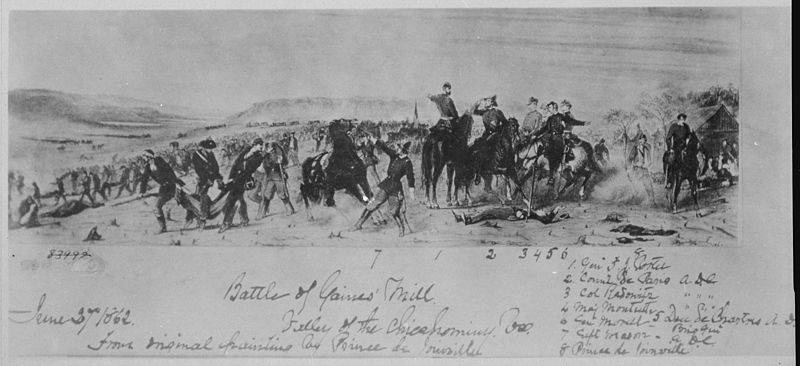
CARTWRIGHT, JR., THOMAS W. (1842-1862). Captain, 5th New York Infantry, Companies G and D. Born in Newark, New Jersey, and a clerk for a pharmaceutical company, Cartwright’s father and elder brother also served in the Civil War. He enlisted at New York City on April 25, 1861, and mustered into Company G of the 5th New York as a private on May 9. He was severely wounded in the thigh at Big Bethel, Virginia, on June 10, 1861, and was carried from the field. After returning to service, he received these promotions: corporal on June 14, 1861, sergeant on or about August 15, 1861, first sergeant on October 5, 1861, second lieutenant on November 5, 1861, and first lieutenant on February 8, 1862.
Severely wounded in the right shoulder by an exploding shell at Gaines’ Mill, Virginia, on June 27, 1862, Cartwright’s gallantry there was cited by Lieutenant Colonel Hiram Duryea, 5th New York, who noted his coolness under fire in his field report dated July 4, 1862, “During all these trying scenes the men under my command have maintained a spirit of cheerfulness and determination, yielding none of their discipline or soldierly pride…”
Cartwright later returned to duty and was promoted to captain on September 1, 1862, effective upon his transfer to Company D. He died from a brain infection at Ebbitt House (a boarding house and later hotel established by William Ebbitt in 1856), Washington, D.C., on December 26, 1862. Davenport, in his book on the 5th New York, described him as “a young man of great promise who when an Orderly Sergeant, and mustered his company, which at the time numbered over ninety members, he called the roll from memory, taking no notes whatever at the time, but never known to omit a name or fail to report an absentee.” His regimental colleagues nicknamed him, “the fiend.” Section 29, lot 13350.
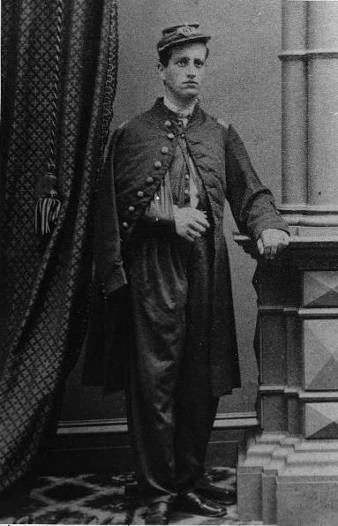
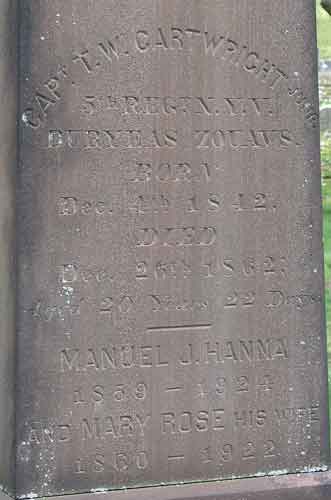
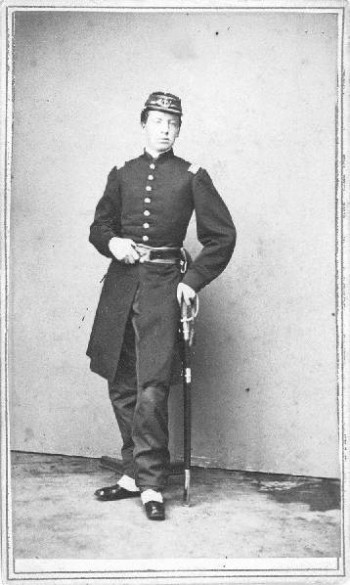
CARVILLE, CHARLES ROBERT (1844-1863). Sergeant, 37th Regiment, New York State National Guard, Company H; second lieutenant, 165th New York Infantry, Company D. Carville, a native of New York, was 6′ tall with blue eyes, light brown hair and a fair complexion. He enlisted at New York City as a private on May 29, 1862, immediately mustered into the 37th National Guard where he rose to sergeant, and served for three months until he mustered out at New York City on September 2.
Carville returned to active duty later that month when he re-enlisted as a second lieutenant on September 22 at New York City, and was commissioned that day into the 165th New York. The 165th New York, also known as the 2nd Battalion Duryee’s Zouaves, was sent to New Orleans and later engaged in the siege of Port Hudson, Louisiana, the longest siege in American military history. On May 27, 1863, Major General Nathaniel Banks ordered the Union forces to advance on the weakly defended northern sector of the fort. A swampy terrain, littered by fallen trees, broke up the formation of the Union soldiers who were subject to heavy fire. Seven officers and 85 enlisted men were killed at Port Hudson, including Carville, who died on May 27. Section 42, lot 8289.
CARY, ISAAC H. (or M.) (1845-1927). Private, 44th Massachusetts Infantry, Company I. A farmer and resident of Readville, Massachusetts, Cary, who was born in Bucksport, Maine, enlisted on August 28, 1862. He mustered into the 44th Massachusetts on September 12, and mustered out on June 18, 1863, at Readville. When he applied for a passport to travel abroad for six months in 1894 and then again in 1905, he was employed as a real estate broker. He was about 5′ 11″ tall with a high forehead, Roman nose, bald head, blue eyes and a light complexion.
Cary also served as a Brooklyn alderman for one term. His name was also on the Republican County Ticket in 1899. As per an article in the Brooklyn Daily Eagle on October 22, 1899, that included a biography of each man running for office, Cary’s experience as an alderman was noted. He was described as a real estate dealer who was a major contributor to the campaign fund. It was also noted that he supported Seth Low for mayor in 1897, was a member of the Hamilton Club and other social and political clubs. His wife was president of the Woman’s Suffrage Club and was prominent in community affairs. His application for an invalid pension was granted, certificate 1,139,522. As per an obituary notice in the Brooklyn Daily Eagle, comrades from Company H of the Veterans Association of the 23rd Regiment, New York State National Guard, were invited to attend his funeral. He last lived at 1 Pierrepont Street in Brooklyn where he died from prostate disease.
According to the Brooklyn Daily Eagle, he bequeathed $5,000 to his church and left an estate valued at a minimum of $20,000 to his children and grandchildren. The landmarked Cary Building at 105 Chambers Street in Manhattan, a cast-iron building built in 1857 by Daniel Badger’s Architectural Iron Works, was owned by his family, and originally sold fancy goods from there. Section 32, lot 14004.
CASE, JR., FRANKLIN (1841-1918). Captain, 15th Michigan Infantry, Companies F and K. Originally from Cutchogue, New York, Case enlisted as a private at Monroe, Michigan, on February 13, 1862, and mustered into Company F of the 15th Michigan. During the time he was a private, the regiment fought at Shiloh, Tennessee (April 6-7, 1862); Corinth, Mississippi (May 21-30, 1862); and Iuka, Mississippi (September 19, 1862). After he rose to second lieutenant on October 1 of that year, he fought at Grand Junction, Tennessee (October 1, 1862), and the following Mississippi battles: Corinth (October 3-4, 1862); Jackson (May 14-15, 1863); the Vicksburg Campaign (May 16-July 4, 1863); and Jackson (July 11, 1863). His regiment then returned to Tennessee fighting at Chattanooga from November 23-30, 1863. In 1864, his unit was in Georgia and saw action in many skirmishes, some of which are enumerated here: Resaca (May 14, 1864); Kennesaw Mountain (June 25, 1864); Decatur (July 2, 1864); the Siege of Atlanta (July 22-August 25, 1864) where he was wounded on July 22 and 28; Jonesboro (August 31, 1864); and Lovejoy’s Station (September 2, 1864). Case rose to first lieutenant on November 9, 1864. He continued to see action in Georgia at Fort McAllister (December 13, 1863) before moving into South Carolina where he was engaged in many battles including: Orangeburg (February 13-15, 1865); Columbia (February 17, 1865); Fayetteville (March 13, 1865). His last action was at Benton, North Carolina, on March 19, 1865. He became a captain on April 28, 1865, and was transferred into Company K at some point. On August 30, 1865, he was discharged at Detroit, Michigan.
Originally a member of Ohio’s Forsyth Post of the G.A.R., Case transferred into the Henry M. Lee Post #21 in 1890 where he held numerous leadership positions including commander. After he recorded all of the battles in which he fought in the G.A.R. Sketch Book, he deemed the Battle of the Hornet’s Nest at Shiloh and the Siege of Vicksburg as the most important. His closest comrades were Colonel F. S. Hutchinson, Major John Bell, Captain James Brown, and Lieutenant E. K. Baxter.
According to the census of 1880, Case lived in Brooklyn and worked in the real estate business. In 1882, his application for an invalid pension was granted, certificate 275,744. The Veterans Schedule for 1890 confirms his military service. The 1900 census indicates that he was employed as a banker. In 1910, he was living with his son in Rutherford, New Jersey, and was working as a treasurer for a mining company. He last lived at 4 Mineral Spring Avenue in Passaic, New Jersey. His death was attributed to pneumonia. Section 197, lot 29786.
CASE, HORACE G. (1831-1891). Private, 74th New York Infantry, Company G. Case was born in Connecticut. After enlisting as a private at New York City on June 6, 1861, he mustered into the 74th on June 27, and deserted on April 25, 1862.
According to the 1870 census, he did silver-plating by trade. He is listed as a plater/plated goods in the New York City Directories for 1875-1876, 1876-1878, and 1891-1892. As per his obituary in The New York Herald, he last lived at 122 St. James Place in Brooklyn with C. S. Dunning (relationship unknown). The cause of his death was nephritis. Section 175, lot 27522.
CASILEAR, JOHN W. (1843-1867). Private, 8th Regiment, New York State Militia, Company E. A New York native, Casilear enlisted at New York City as a private and mustered into Company E of the 8th Regiment for a three month term in 1861, mustering out when his enlistment expired. His last address was in Kensico in Westchester County, New York. Casilear died from tuberculosis. Section 150, lot 14839.
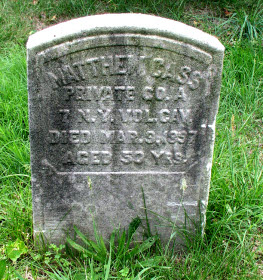
CASS, MATTHEW (or MATHEW) (1847-1897). Private, 7th New York Cavalry, Company C; 125th New York Infantry, Company D. Of Prussian origin, Cass enlisted as a private at Troy, New York, on October 22, 1861, immediately mustered into the 7th New York Cavalry, and mustered out on March 31, 1862, at Washington, D.C. He re-enlisted as a private on August 7, 1862, at Troy and mustered into the 125th New York on August 27. Twice taken as a prisoner of war, he was first captured at Harpers Ferry, Virginia, on September 15, 1862, and paroled there the next day. He was then taken prisoner at Deep Bottom, Virginia, on August 15, 1864. Cass was held at Salisbury, North Carolina, and Andersonville, Georgia, then paroled on an unknown date. He mustered out at Albany, New York, on May 30, 1865.
The Brooklyn Directory for 1873-1876 lists Cass as a peddler. According to the census of 1880, he was employed as an ice dealer; the Brooklyn Directory for 1880-1882 lists him as a teamster. The Brooklyn Directory for 1885 listed him as a laborer. In 1889, his application for an invalid pension was granted under certificate 444,232. The Veterans Schedule for 1890 for Brooklyn confirms his military record and records his imprisonments. A member of the Cushing Post #231 of the G.A.R. as of January 20, 1890, he also belonged the Regimental Association of the 125th New York. He last lived at 557 Third Avenue in Brooklyn. His death was attributed to apoplexy. Mary Cass, who is interred with him, applied for and received a widow’s pension shortly after his death, certificate 445,832. Section 114, lot 8999, grave 428.
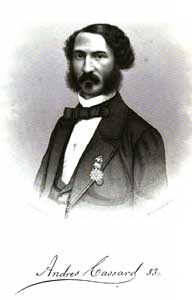
CASSARD, ANDRES (1823-1894). Captain, 149th New York Infantry, Company G. Of Cuban origin, Cassard enlisted as a second lieutenant on March 24, 1864, when he was 40 years old. On April 2, 1864, he was commissioned into the 149th New York, was promoted to captain 20 days later when he was assigned to Company G, and discharged on December 20 of that year.
In 1885, his application for an invalid pension was granted, certificate 304,185. He last lived at 139 West 70th Street in Manhattan. Cassard died from a stomach tumor. Emilia Cassard, who is interred with him, applied for and was granted a widow’s pension in 1904, certificate 579,828. Section 187, lot 22715, grave 5.
CASSIDY, ANDREW (1841-1907). Sergeant, 84th New York (14th Brooklyn) Infantry, Company F; 5th New York Veteran Infantry, Company G. He enlisted at Brooklyn, his birthplace, on July 31, 1861, and mustered into the 14th on August 4. Subsequently promoted to corporal and then sergeant, he transferred into the 5th Veterans on June 2, 1864, serving until he was discharged later that month on June 30.
In 1884, he applied for an invalid pension that was granted under certificate 307,695. He last lived in Brooklyn. His death was attributed to cancer. Mary Cassidy applied for a widow’s pension in 1907 that was granted under certificate 635,934. Section 62, lot 5864.
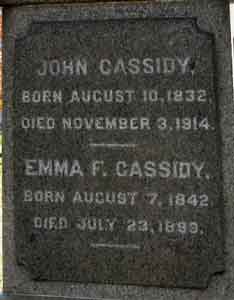
CASSIDY, JOHN (1832-1914). Private, 8th Regiment, New York State Militia, Company F. After Cassidy enlisted as a private at New York City in 1861, he served for three months with the 8th Regiment. He applied for and was granted a pension in 1907, certificate 1,140,604. Cassidy was a member of Mansfield Post #35 of the G.A.R., an organization of Civil War veterans. He also belonged to the Royal Arcanum of Brooklyn. His veteran status was noted in his New York Times obituary. His last residence was 302 Lafayette Avenue in Brooklyn. Cassidy died from nephritis. Section 198, lot 24220, graves 7 and 8.
CASSIDY, JOHN (1838-1929). Private, 127th New York Infantry, Company G. Of Irish birth, he enlisted on July 25, 1862, mustered in on September 8, 1862, and was discharged for disability at the Fairfax Seminary Hospital in Alexandria, Virginia, on April 15, 1863. His last residence was on West 122nd Street, Manhattan. He died from arteriosclerosis at age 91. Section 204, lot 27050.
CASSIDY, JOSEPH (1816-1891). Private, 132nd New York Infantry, Company F. Originally from Ireland, he enlisted as a private on July 21, 1862, mustered into the 132nd New York that day, and continued with the same unit on September 5. Other details of his service are not known. Most likely, he was the father of William (see). He last resided at the Alms House in New York City. His death was attributed to enteritis. Section 29, lot 11382.
CASSIDY, WILLIAM A. (1841-1883). Private, 71st Regiment, New York State National Guard, Company B. Born in New York City, he enlisted and mustered into the 71st on May 27, 1862, and mustered out with his company three months later on September 2. He was likely the son of Joseph (see), who also served in the Civil War. He last resided in Hoboken, New Jersey. The cause of his death was typhoid fever. Section 29, lot 11382.
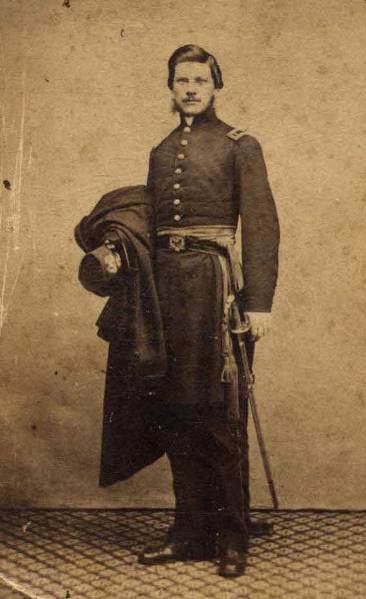
CASSIN, WALTER L. (or J.) (1833-1863). Major, 15th New York Engineers. After enlisting at New York City as an adjutant on May 9, 1861, he was commissioned into the 15th New York Engineers on June 25. In a field report from Fredericksburg, Virginia, on December 12, 1862, his commanding officer Brigadier General Daniel P. Woodbury, United States Army, praised his officers including Cassin as “…untiring during the night and day, going wherever duty called them, regardless of danger.” He was promoted to major on January 30, 1863, and died of remittent fever on October 8, 1863, at Washington, D.C. Labella G. Cassin applied for and was granted a widow’s pension on January 25, 1864, certificate 31,631. Section 169, lot 14512.
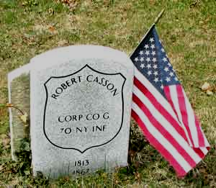
CASSON, ROBERT (1813-1867). Corporal, 70th New York Infantry, Company G. Born in Longton, Lancashire, England, he came to New York City with his parents and siblings in 1826. He enlisted at New York City as a corporal on May 1, 1861. He was later reduced to ranks and mustered out on July 1, 1864, at New York City. His last residence was at 318 Eighth Avenue in Manhattan. Casson died from pneumonia. Marietta Casson applied for a widow’s pension in 1870, application 441,764. Section 116, lot 4073, grave 278.
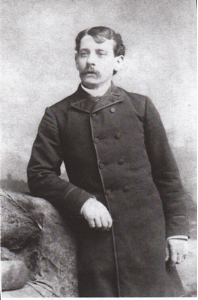
CASTINE, FREDERICK W. (1841-1893). Private, 173rd New York Infantry, Companies D and H. A Brooklyn native and trumpeter by trade, Casine was 5′ 4″ tall with black eyes, brown hair and a dark complexion. After enlisting as a private at Brooklyn on September 2, 1862, he mustered into Company D of the 173rd New York on October 30. The muster roll indicates that he was also known as Frederick Warner. He deserted on January 1, 1863, from a ship in New York Harbor. The muster roll also indicates that he re-enlisted on February 15, 1864, but his soldier history states that he was arrested on February 15, 1864. Castine was taken as a prisoner of war at Pleasant Hill, Louisiana, on April 9, 1864, and returned to his unit in March 1865. As a prisoner, he was supposed to be discharged by General Order 77 but no discharge papers were furnished at muster out. He was transferred into Company H at some point.
According to the Brooklyn Directories for 1870-1873 and 1874, Castine was working as a driver; the Brooklyn Directory for 1879 lists him as a conductor and the Brooklyn Directory for 1880-1882 notes that he was a watchman. As per the Brooklyn Directories for 1886 and 1890-1892, he was an engineer. His obituary in the New York Herald reports that he was a Freemason and a member of the Order of Tonti, a fraternal organization whose members invested in tontine insurance, paying in an annual sum over a period of years and then dividing the proceeds plus interest among those who were still alive at the end of the stated period. (This kind of insurance became illegal in New York in 1906.) He also belonged to the Independent Order of Odd Fellows and the Ancient Order of United Workmen (A.O.U.W.), fraternal and benefit societies. Members of the aforementioned organizations were invited to his funeral. He last lived at 185 Java Street in Brooklyn. His death was attributed to grippe (influenza). In 1894, his wife, Mary E. Castine, applied for a widow’s pension, application 602,873, but it was not certified. Section 137, lot 28393, grave 2.
CASTLE, ARTHUR HENRY (1839-1873). Private, 13th Regiment, New York State National Guard, Company E. A Canadian by birth, he enlisted at Brooklyn and mustered into the 13th National Guard on May 28, 1862, and mustered out there after three months of service on September 12. He last lived at 210 Hamilton Avenue in Brooklyn. His death was attributed to intemperance. Section 66, lot 6006.
CASWELL, CHARLES S. (1827-1907). Captain, 119th New York Infantry, Company I. Originally from Boston, Massachusetts, Caswell enlisted at New York City as a captain on August 25, 1862. He was commissioned into the 119th New York on September 10, and was discharged on December 19, 1862, at Centerville, Virginia. A document from October 31, 1899, details the purchase by Caswell of his lot at Green-Wood for $360. His last address was in Watertown, Connecticut. The cause of his death was listed as senility. On May 19, 1908, his wife placed a memorial tribute to her husband in The New York Herald, commemorating the first anniversary of his death; two years later, on May 19, 1910, another memorial notice was posted by his wife in the same newspaper. Section 188, lot 15128, grave 2.
CATHIE, JAMES (1838-1862). Private, 5th New York Infantry, Company G. A native of Scotland, Cathie was baptized at Haddington, Scotland, on January 20, 1839, when he was one month old. His family departed from Glasgow, Scotland, aboard the Sarah and arrived in New York City on June 5, 1842; there were eight children in the family. William Cathie, his father, became a naturalized citizen on October 24, 1856. During the Civil War, Cathie enlisted as a private at New York City on August 8, 1862, and mustered into Company G of the 5th New York that same day. His muster roll notes that he was a plumber who was 5′ 6″ tall with blue eyes and auburn hair. As per Battle of Second Manassas (another name for Second Bull Run) by Brian C. Pohanka, “Recruit James Cathie stood his ground alongside Irish-born veteran James Patterson (see) in the ranks of Company G. Grimly reloading amid the slaughter, Cathie turned to Patterson and said, “Look out for Siss__.” A fatal bullet cut him down before he could finish….” On August 30, 1862, at that battle, the 5th New York lost 123 men in five minutes, the greatest loss of life in any single infantry regiment during the Civil War.
News of Cathie’s death did not reach his family immediately. William Cathie, his father, put a notice in the New York Herald on December 28, 1862, looking for information about his son stating he had been missing since the Battle of Second Bull Run, Virginia, on August 30, 1862. Identified as a member of Company G of Duryee’s Zouaves, he was described as follows: medium height, 24 years of age, fair complexion, blue eyes, and tattoos of an anchor and his initials on one arm. The notice ended, “Any information concerning him will be gratefully received by his parents.” William Cathie lived at 343 Second Avenue in New York City.
On July 23, 1867, Agnes Cathie, his mother, applied for and received a survivor’s pension, certificate 105,173. William Cathie, his father, applied for a survivor’s pension on May 13, 1867, application 143,749, but there is no evidence that it was certified. In support of William Cathie’s application, the pastor of his church, the First Reformed Presbyterian Church in New York City, attested on February 19, 1867, that William Cathie had “unfortunate” experiences in business in 1858 and had depended on periodic payments from James, his son, who was a journeyman plumber. It is unclear where James Cathie is buried or if his body was ever recovered; his parents are buried in Section 24, lot 6781.
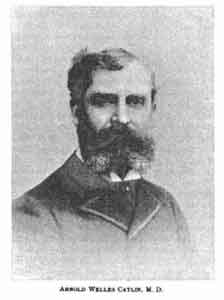
CATLIN, ARNOLD WILLIS (1842-1931). Assistant surgeon, Union Army. An article in the Brooklyn Daily Eagle in 1879 notes that Catlin was a member of Psi Upsilon Fraternity while in college, class of 1862; his name was identified as a Brooklyn member in that fraternity’s catalogue. According to the Veterans Census for 1890, Catlin was an assistant surgeon in the Union Army during the Civil War. The specific details of his service are unknown.
In the 1871 Brooklyn Directory, he is listed as a physician at 52 St. James Place in Brooklyn; he is listed as a physician in the Brooklyn Directories for 1873-1876, 1880-1882, 1894-1996, 1896-1998 and 1913. He was also a member of the Long Island Historical Society. A director of the Brooklyn Public Library, his last residence was 207 Greene Avenue in Brooklyn. Catlin died from arteriosclerosis. According to a posting in the Brooklyn Daily Eagle related to the filing of his will on May 9, 1831, he left an estate valued at about $6,000. Section 115, lot 21012.
CATLIN (or CATLEN), THOMAS G. (1810-1874). Surgeon, United States Volunteers Medical Staff. Originally from Vermont, the 1858 Brooklyn Directory lists Catlin as a physician whose practice was on Montague Street. The 1860 census lists him as a physician who lived with his wife and three children in Porter, New York (Niagara County); his real estate was valued at $1,000 and his personal property was valued at $300. During the Civil War, Catlin enlisted as a surgeon on April 4, 1862, and was immediately commissioned into the U.S. Volunteers Medical Staff with the rank of major. He is listed as among those who served at Fort Niagara, New York Harbor, from January through June of 1862. He resigned on April 7, 1863.
Catlin is listed as a physician in the Brooklyn Directories for 1865 and 1867-1870; at that time, he lived at 2 Sydney Place. The 1870 census shows that he lived in Brooklyn with his wife and two adult daughters; his real estate was valued at $14,000 and his personal property was worth $1,000. His last name is misspelled in the Green-Wood database as Catlen; his wife, who is interred with him, is listed as Catlin. Section 70, lot 2844.
CAVANAGH, (or KAVANAUGH, KAVANAGH) JOHN (1843-1862). Private, 51st New York Infantry, Company K. Of Irish origin, he enlisted at New York City as a private on August 23, 1861, and mustered into the 51st New York on September 7. He was killed in action at New Berne, North Carolina, on March 14, 1862. Section 168, lot 17355.
CAVANAUGH, IRA G. (1836-1917). Private, 6th Indiana Infantry, Company B. Born in Bartholomew County, Indiana, he enlisted as a private on April 25, 1861, mustered into the 6th Indiana the next day, and mustered out of service after three months on August 2, 1861, at Indianapolis, Indiana.
After the Civil War, Cavanaugh was employed as a marble-cutter for monuments. An active member of the Grand Army of the Republic, he was commander of the James H. Perry Post #89. On January 26, 1905, he applied for and was granted an invalid pension, certificate 1,107,590. At the time of his death, he was a resident at the Sunshine Sanitarium in Brooklyn. He died from heart valve disease. In 1917, Sarah Cavanaugh applied for a widow’s pension, application 1,105,919, but there is no certificate number. Section 134, lot 34733, grave 5.
CAVE, FRANK E. (1832-1886). Private, 13th New York Heavy Artillery, Battery G; 6th New York Heavy Artillery, Battery M. Cave, who was born in England, enlisted as a private on March 30, 1864, at New York City, the same date that he mustered into the 13th New York Heavy Artillery. On July 18, 1865, he transferred into the 6th Heavy Artillery where he served until he mustered out on August 24, 1865, at Washington, D.C.
In civilian life, Cave worked as a store clerk. He may be the Frank Cave who is listed as a bookkeeper in the 1880-1882 Brooklyn Directory. He applied for and was granted an invalid pension. His last residence was 290 McDougal Street in Brooklyn. Originally buried in Internal Olivet Cemetery after his death on May 11, 1886, he was re-interred at Green-Wood on September 27, 1886. Emily Cave applied for and received a widow’s pension. Section 183, lot 2217.
CAYTON, WILLIAM B. (1840-1869). Private, 16th New York Heavy Artillery. Originally from New Jersey, Cayton enlisted as a private at Fishkill, New York, on January 4, 1864, and mustered into an unassigned company of the 16th New York Heavy Artillery two days later. He mustered out on May 7, 1865, at Hart’s Island in New York Harbor. Cayton last lived in Rockland County, New York. His death was attributed to drowning. Section 184, lot 19115.
CELLA, ANTONIO (1836-1874). Private, 39th New York Infantry, Company A. A native of Italy, he enlisted at New York City on May 28, 1861, and mustered into the 39th that day. The 39th New York, also called Garibaldi’s Guards, was composed of several companies with different immigrant backgrounds. Cella was discharged for disability on May 26, 1862, at Philadelphia, Pennsylvania. Cella last resided at 158 Spring Street in Manhattan. He died from ascites (build-up of fluid in the abdomen usually attributed to liver disease). Section 124, lot 21882.
CHADWICK, EDWARD (1835-1877). Private, 133rd New York Infantry, Company H; rank unknown, United States Navy. Of Irish birth, Chadwick enlisted as a private at Brooklyn on August 28, 1862, and mustered into the 133rd New York on September 24. He transferred into the Navy on June 30, 1864. After the War, he worked as a brass finisher. He last lived at 364 Madison Street in Manhattan. The cause of his death was tuberculosis. Section 15, lot 17263, grave 1405.
CHADWICK, JOHN (1834-1881). Corporal, 25th New York Infantry, Company E. Born in England, he enlisted on May 11, 1861, at New York City, as a corporal. He mustered into the 25th the next month on June 14, and deserted at Alexandria, Virginia, on August 9, 1861. His last residence was 201 Prince Street in Manhattan. He died from tuberculosis. Section B, lot 8575.
CHAMBERLAIN, BENJAMIN F. (1830-1871). First lieutenant, 71st Regiment, New York State Militia, Company I. A native of New York State, Chamberlain enlisted at New York City as a first lieutenant on April 19, 1861, was commissioned into the 71st the next month on May 3, and mustered out on July 31, 1861, at New York City. He died at 8th Avenue in Newark, New Jersey, but last resided in New York. The cause of his death was dropsy (edema). Section 167, lot 17094.
CHAMBERLAIN, WARREN W. (1835-1862). Captain by brevet; first lieutenant, 12th New York Infantry, Company G; 14th Regiment, Regular United States Army. Born in New York, he was a cadet at the United States Military Academy from 1855 to 1857. On April 19, 1861, he enlisted at New York City and was commissioned into the 12th New York as a first lieutenant on May 2, 1861. He transferred into the Regular Army on June 28, 1861, where he was commissioned a first lieutenant in the 14th Regiment. Wounded at the Battle of Second Bull Run, Virginia, he died on August 30, 1862, and was brevetted to captain for gallant and meritorious service at that battle. He was interred at Green-Wood on December 22, 1862. Section 54, lot 2049.
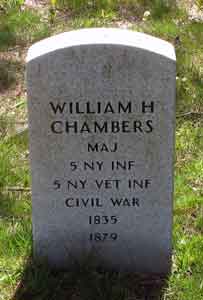
CHAMBERS, WILLIAM H. (1835-1879). Captain, 5th New York Infantry, Companies H, C, D, and E; 5th New York Veteran Infantry, Companies B and I. Born in Manchester, England, and reputed to be a veteran of the British Army, he was a machinist at the time he enrolled, and was 5′ 7½” with blue eyes and light brown hair. After enlisting as a sergeant at New York City on April 25, 1861, Chambers mustered into Company H of 5th New York Infantry on May 9. Initially promoted to third sergeant on July 20, 1861, he was reduced to private on August 2, and then promoted to fourth sergeant on October 2. At some point, he was promoted to first sergeant, then to second lieutenant on August 31, 1862, the same day he was transferred to Company C. He became a first lieutenant on October 16, 1862, and was transferred that day to Company D. Subsequently, he rose to captain on February 23, 1863, effective upon his transfer that day to Company E. On May 14, 1863, he mustered out at New York City.
Chambers returned to service as a private in Company B of the 5th Veterans on February 26, 1864, and became captain on July 12 of that year effective upon his transfer that day to Company I. He was wounded at Petersburg, Virginia, on August 21. Recommended on April 18, 1865, by his commanding officer, Brigadier General Joseph Hayes, “for gallantry and coolness in the Battle of Five Forks on the 1st of April, he having command of the left company of the regiment…,” he was brevetted major, dating to April 1, 1865, “for gallant and meritorious services at the Battle of Five Forks, Virginia.” On August 14, 1865, however, he was dismissed by court-martial for absence without leave. He might have lived in Oyster Bay, Long Island, after the Civil War. In 1891, Mary Chambers applied for a widow’s pension, application 519,996, but it does not have a certificate number. Section 121, lot 11189, grave 213.
CHANDLER, FRANK HILTON (1836-1920). Musician, 4th Vermont Infantry, Band. Originally from Randolph, Vermont, although the Green-Wood database incorrectly says Connecticut, the 1860 census notes that Chandler lived in Rockingham, Vermont, and worked as an organ-maker. Chandler enlisted as a private as a Rockingham resident on September 9, 1861, and mustered into the Band of the 4th Vermont Infantry as a musician on September 21. He was discharged on August 9, 1862. In June 1863, he was registered for the draft in Hamden and Berkshire Counties, Massachusetts, and gave his occupation as armorer.
Chandler lived in Brooklyn at the time of the 1870 census and had a piano agency. The Brooklyn Directories for 1870-1873 and 1873-1876 list him in the piano business on Montague Street; the Brooklyn Directory for 1890-1892 lists him as having a piano business at 300 Fulton Street. On January 17, 1892, the Brooklyn Daily Eagle noted that Chandler was treasurer of the Vermont Society in Brooklyn, an organization founded a year earlier. That article notes that about one hundred ex-Vermonters and their guests celebrated at a banquet at the Brooklyn Academy of Music on the anniversary of the date that Vermont became a sovereign state in 1877. The census of 1900 reports that he had been married for twenty-seven years, lived in Brooklyn, and was a piano dealer. On August 16, 1901, the Brooklyn Standard Union listed Chandler as a member of the Vermont Society of Brooklyn who commemorated the anniversary of the Battle of Bennington, a Revolutionary War battle that took place on August 16, 1777; many members of the society returned to Bennington where special services were held in all of the churches. He was also a member of the New England Society.
In 1906, Chandler’s application for a pension was approved, certificate 1,125,012. The 1910 census shows that he was married, lived on Clinton Street in Brooklyn, and worked as a merchant. He last lived at 46 South Oxford Street in Brooklyn. His death was attributed to lobar pneumonia. Chandler was originally buried in Green-Wood Cemetery. His remains were removed and re-interred at Randolph Cemetery in Vermont on June 27, 1921.
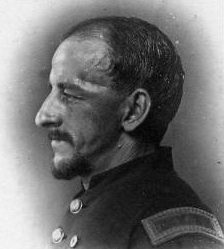
CHANDLER, THOMAS W. (1830-1882). Second lieutenant, 65th New York Infantry, Company A; sergeant major, 67th New York Infantry, Company F. Of English origin, he may be the Thomas W. Chandler who is listed as a cutter in the Brooklyn Directory for 1857-1862. (That same man is listed as a cutter/shirt cutter in Brooklyn Directories through 1876). During the Civil War, he enlisted as a private at Astoria, Queens, on May 10, 1861, and mustered into Company F of the 67th New York on June 20. Chandler was promoted to corporal on October 9, became sergeant on April 15, 1862, and, on March 1, 1863, was promoted to sergeant major and transferred to the Field and Staff.
After re-enlisting, Chandler was commissioned a second lieutenant in Company A of the 65th New York on April 29, 1864. At the Battle of Petersburg, Virginia, on March 25, 1865, he was shot above the left eye by a Minie ball. Here is the account of his wounding in his Brooklyn Daily Eagle obituary: “He passed through the entire period of the war until March 25, 1865, without injury, when after the capture of Fort Steadman, in an attempt to advance the picket line, he received a gunshot wound in the left temple, which penetrated the brain. After several weeks he succeeded in obtaining a furlough, reached home in safety and placed himself under the charge of Dr. Johnson, of Henry Street, who, after considerable difficulty, succeeded on the 8th of May in removing the ball, which weighed one and a quarter ounces, from his head, it having been in his brain for six weeks and two days.” Chandler then was discharged from military service for disability due to wounds.
In 1869, Chandler applied for and received an invalid pension, certificate 101,077. His obituary notes that he lived in Brooklyn for thirty years and was a member of the old New York Fire Department. His last residence was 161 Washington Avenue in Brooklyn. His death was attributed to brain congestion resulting from his Civil War wound. He was survived by his wife, two sons and a daughter. Fannie E. Chandler received a widow’s pension shortly after his death, certificate 199,826. Section 142, lot 24356.
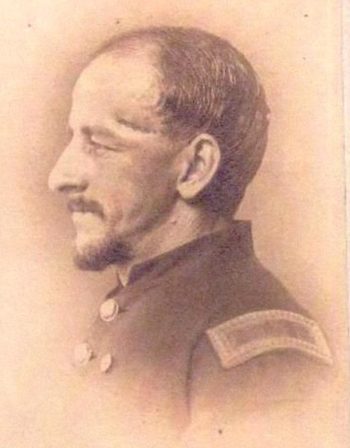
CHAPIN, GEORGE C. (1836-1925). Sergeant, 22nd Regiment, New York State National Guard, Company F. He enlisted as a private on May 28, 1862, mustered into the 22nd the same day, and mustered out after three months on September 5. In 1863, he served in the same regiment and company as a sergeant for 30 days. He last resided in Poughkeepsie, New York, where according to the censuses of 1900, 1910 and 1920, he was a patient at the Hudson River State Hospital. He died from arteriosclerosis. Section 161, lot 11589.
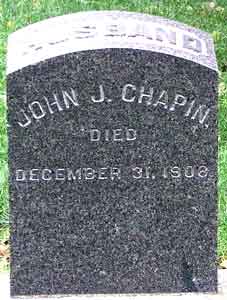
CHAPIN, JOHN J. (1843-1908). Private, 9th New York Infantry, Company E. After enlisting at his birthplace, New York City, on April 23, 1861, Chapin mustered into the 9th on May 4. After serving two years, he mustered out at New York City on May 20, 1863.
Chapin is listed as a clerk in the Brooklyn Directories for 1867-1870 and 1873-1876. According to the censuses of 1880 and 1900 census, he was employed as a bank clerk. He is also identified as a clerk 1n the Brooklyn Directory for 1884-1886 and the New York City Directory for 1890-1892. His military service was confirmed by the 1890 Veterans Schedule. In 1904, his application for an invalid pension was granted, certificate 1,094,316. He last lived at 92 Decatur Street in Brooklyn. His death was attributed to apoplexy. Ida Chapin, who is interred with him, applied for and received a widow’s pension in 1909, certificate 827,451. Section 24, lot 4871, grave 1.
CHAPMAN, ALFORD (or ALFRED) B. (1835-1864). Lieutenant colonel, 57th New York Infantry, Company A. Born in New York City, he enlisted there on August 20, 1861, as a captain, and was commissioned into Company A of the 57th New York on October 19, 1861. Promoted to major and transferred to Field and Staff on February 3, 1862, he served in all of the battles of the Peninsula Campaign. He rose to lieutenant colonel on September 17, 1862, where he wrote about the Battle of Antietam, Maryland, from Bolivar Heights, Maryland, on September 24:
“About noon of that day we became actively engaged with the enemy, our brigade having relieved that of General Meagher [the Irish Brigade]. This regiment and the Sixty-sixth Regiment received orders to march on the enemy, who were at that time drawn up in a deep ditch at the foot of the hill on which we were, and from whence they were pouring a galling fire into our ranks. Animated by the presence of both their brigade and division commanders, the regiment moved forward with a determined enthusiasm I have never seen excelled. In a few minutes we had cleared the ditch of every living enemy; and were driving them in great disorder through the cornfield beyond…Remaining a short time in line at the farther end of this corn-field, I received orders to move the regiment to the support of a battery on our left and rear. I filed round the foot of the hill under a terrible fire of grape and canister, which fortunately caused us comparatively slight loss, being aimed too high…”
Severely wounded at Fredericksburg, Virginia, under Burnside, he was leading his command in protecting the pontoon bridge on the Rappahannock. Subsequently, Chapman commanded the 57th at Gettysburg, Pennsylvania. On August 5, he wrote in his report about Gettysburg from Morrisville, Virginia, “…On the morning of July 3, I was directed to erect slight breastworks in front of my regiment, the division being then in line to the right of the field in which it was engaged the day previous. This was done in a short time, and proved of great service during the day in protecting the men from the fire of artillery. During the day we sustained the most severe and long-continued artillery fire of the war, followed by a most determined infantry attack, which was successfully repulsed. In our immediate front the enemy’s infantry did not succeed in advancing beyond our picket line excepting as prisoners of war…” After serving in all the battles and marches of the Army of the Potomac, he was killed at the Battle of the Wilderness, Virginia, commanding the division’s skirmish line on May 5, 1864. When he was carried off the battlefield, he asked for pen and ink and wrote to his parents in Brooklyn, “I am mortally wounded. Do not grieve for me. My dearest love to all. Alford.” According to William Swinton’s History of the Seventh Regiment (1876), Chapman served in Company D of that unit; it is not clear when his service took place. He was interred at Green-Wood on May 14, 1864. Section 169, lot 13800.
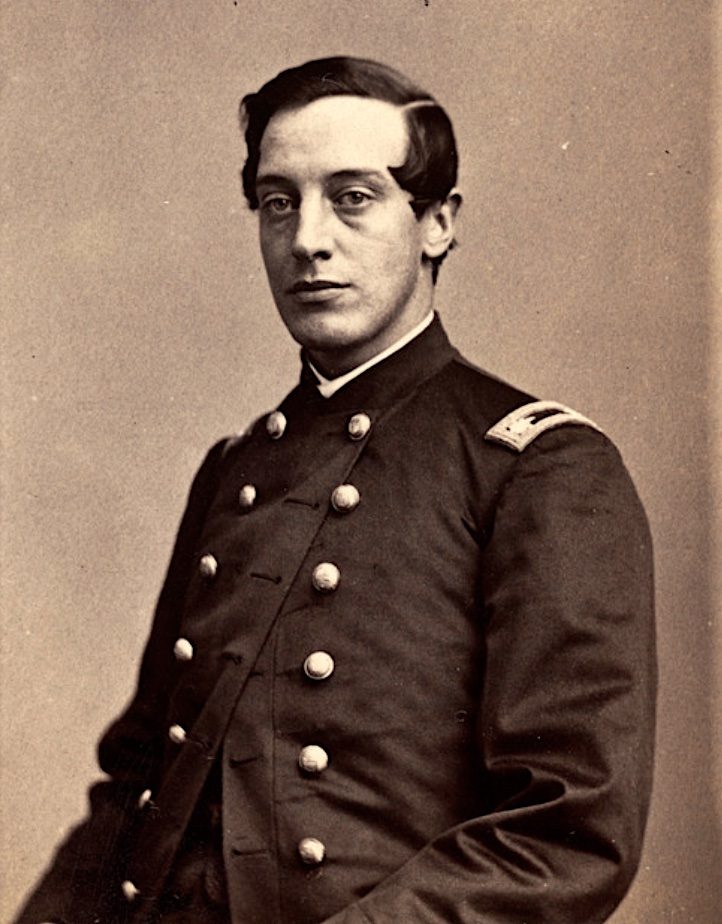
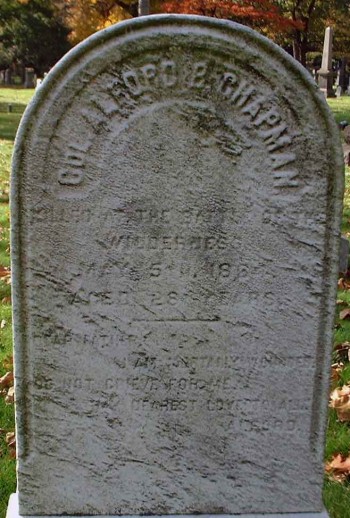
CHAPMAN EBEN B. (1840-1888). Sergeant, 62nd New York Infantry, Company A. Chapman, who was born in New York City, enlisted there as a private on May 22, 1861, and mustered into Company A of the 62nd New York on June 30. He was promoted to corporal of his company on November 24, 1861, to sergeant on an unknown date, and mustered out on June 29, 1864, at Petersburg, Virginia. Shortly thereafter, he re-enlisted as a corporal at New York City on September 27, 1864, and rejoined his regiment and company until he mustered out on August 30, 1865, at Fort Schuyler, New York Harbor.
According to the 1880 census, Chapman was employed as a railroad car driver. His last residence was 367 West 52nd Street in Manhattan. Chapman died from bronchitis. A government-issued tombstone for Civil War veterans was installed at his grave-site. Section 4, lot 21316, grave 113.
CHAPMAN, GEORGE (1846-1919). Private, 93rd New York Infantry, Company A. Of English birth, he enlisted at Brooklyn on December 22, 1864, mustered that day into the 93rd New York, and mustered out on June 29, 1865, at Washington, D.C. He last lived in Woodhaven, Queens. His death was caused by nephritis. Section 12, lot 10439.

CHAPMAN, HENRY K. (1829-1862). Second lieutenant, 4th New York Infantry, Companies B and C. After enlisting as a first sergeant at New York City on April 22, 1861, he mustered into the 4th New York’s Company B on May 9. He was promoted to second lieutenant on December 7, 1861, and transferred to Company C on August 15, 1862. Wounded at Antietam, Maryland, on September 17, 1862, he succumbed to his wounds a few days later. He was interred at Green-Wood on July 31, 1863. Section 115, lot 13536 (Soldiers’ Lot), grave 27.
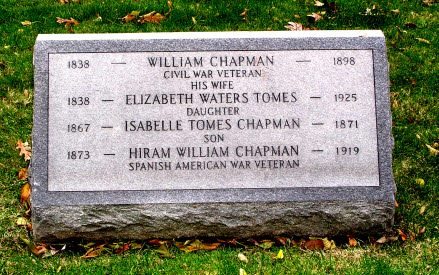
CHAPMAN, WILLIAM (1838-1898). Second lieutenant, 23rd Regiment, New York State National Guard, Company H. After enlisting as a second lieutenant at Brooklyn on June 18, 1863, he was immediately commissioned on June 18, 1863, and mustered out 30 days later on July 22 at Brooklyn. His gravestone simply states, “Civil War Veteran.” Members of the 23rd Veterans Association announced his death and invited comrades to his funeral in an obituary in the Brooklyn Daily Eagle. He last lived at 334 Greene Street in Brooklyn. Chapman died from nephritis. Section 7, lot 8130.
CHAPPELL (or CHAPPEL), GEORGE (1830-1911). Captain, 28th Regiment, New York State National Guard, Company A; private, 13th Regiment, New York State Militia, Company B. A native New Yorker, he was a merchant according to the census of 1860 with a personal wealth listed at $4,000. Chappell first served in 1861 for three months with the 13th Regiment from April 23 through August 6. He re-enlisted at Brooklyn on August 10, 1864, was commissioned into the 28th Regiment on August 31, and mustered out after 100 days on November 13 at New York City.
As per the census of 1870, Chappell had a personal wealth of $8,000, but no occupation is listed. According to his obituary in the Brooklyn Daily Eagle, he was an inventor of a burner that obtained white light from illuminating oil and had a brass and chandelier business in Chicago until the Great Fire of 1871. The 1890 Veterans Schedule confirms his military service and notes that he was an insurance broker. In 1894, he applied for and received an invalid pension under certificate 940,204. An article in The New York Times on April 21, 1898, indicates that General Chappell obtained authority to raise a brigade or division to help President McKinley, along with other fraternal organizations in the metropolitan area that expressed their loyalty and patriotism. He was a grand commander of the New York State G.A.R., a vice commander of the New York State National Guard, and a 32nd degree Freemason. According to the census for 1900, he was living in the Bronx and was a real estate agent; in 1910, he was living in Hempstead, New York, where he was thrown from a Long Island Railroad train at Garden City causing a severe injury. He last lived at 1003 Boston Road in the Bronx. His death was attributed to pneumonia. Helen Chappell applied for and received a widow’s pension in 1911 under certificate 733,811. His son, George P. Chappell, was a noted brownstone architect. Section 69, lot 11921.
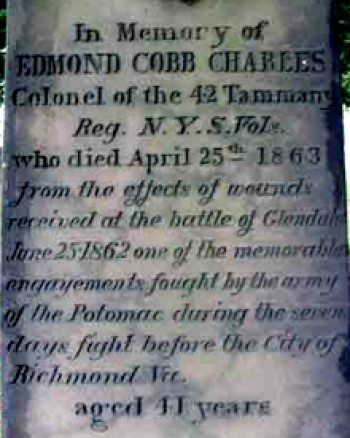
CHARLES, EDMOND (or EDMUND) COBB (1821-1863). Colonel, 42nd New York Infantry; lieutenant colonel, 25th New York Infantry. Originally from England, he enlisted as lieutenant colonel on May 19, 1861, was commissioned into the Field and Staff of the 25th New York on June 28, and resigned on October 4, 1861. One month prior to his resignation he was treated for a fistula of the anus while on furlough in New York City. The New York State Medical Department’s report of that operation (signed by Dr. Mott) deemed him unfit for duty for several weeks and recommended his discharge for disability.
Charles re-enlisted and was commissioned colonel of the 42nd New York (the Tammany Regiment) on January 7, 1862. Severely wounded and captured at White Oak Swamp, Virginia, on June 30, 1862, he was confined at Libby Prison in Richmond, Virginia, until July 17. In his field report of July 5, 1862, from Harrison’s Landing, Virginia, Brigadier General John Sedgwick, United States Army, said of Charles and other officers in his command, “All were ready at all times, in spite of the severe and almost unparalleled fatigues they were compelled to undergo, to meet the enemy at a moment’s notice…” He was discharged for disability due to his wound in March 1863, and died the next month on April 25. The remains of Colonel Charles lay in state in the Governor’s Room at City Hall on the afternoon of April 27, 1863, attended by members of several New York regiments and accompanied by the regimental band. He last resided at 48 Bleecker Street in Manhattan. Section K, lot 13501.
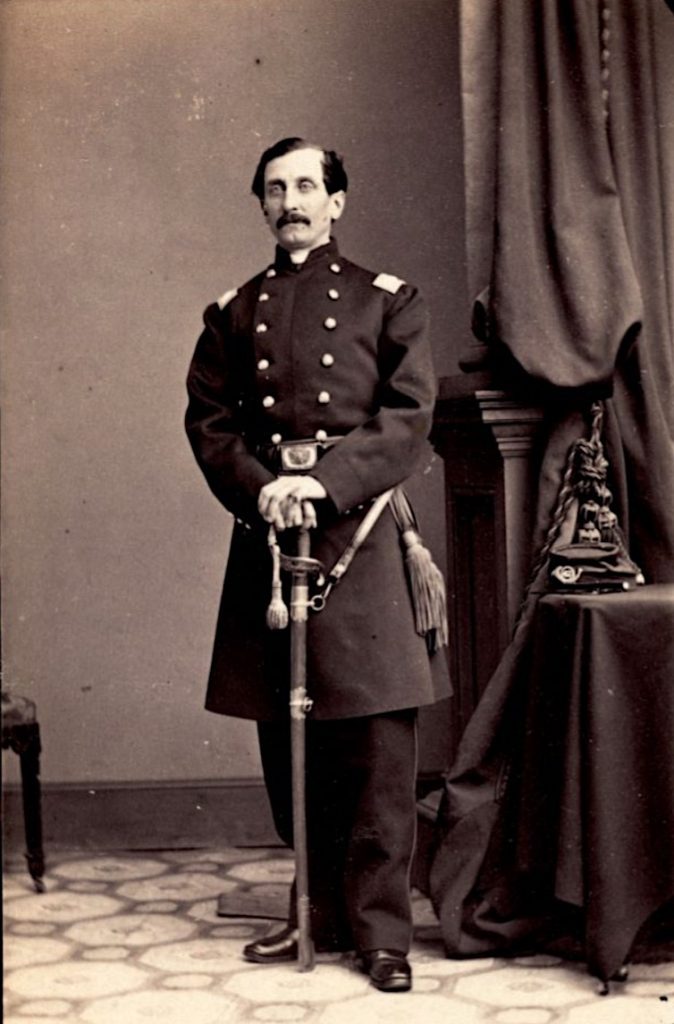
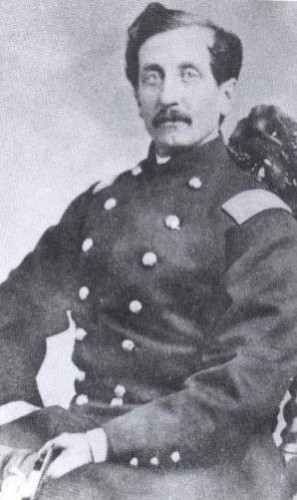
CHARLOTTE, CICERO J. (1843-1869). Private, 1st North Carolina Cavalry, Company H, Confederate States of America. A native of North Carolina, Charlotte enlisted as a private on August 2, 1863, at Culpepper, Virginia, and mustered into the 1st North Carolina Cavalry, a Confederate regiment. The muster rolls indicate that he was transferred into that regiment but give no details. On September 13, 1863, at the Battle of Culpepper Court House, Virginia, he was taken as a prisoner of war and confined to the Old Capitol Prison in Washington, D.C., on September 19. Records show that he was at Hammond General Hospital on April 1, 1864, suffering from chronic diarrhea, then returned and confined to the military prison camp at Point Lookout, Maryland, on October 1. Charlotte returned to the Hammond General Hospital on February 2, 1865. He was incarcerated there until he was exchanged at Cox’s Landing, James River, Virginia, on February 13, 1865. He was paroled at Raleigh, North Carolina, on May 24, 1865, after Lee’s surrender.
Living in New Berne, North Carolina, and employed as a clerk on November 10, 1865, Charlotte petitioned President Andrew Johnson asking for clemency under the Amnesty Proclamation of May 29, 1865, and stating that “he has taken in good faith the oath of amnesty with the unreserved determination of maintaining to the extent of his ability, the territorial integrity and stability of the government.” Another petition for his pardon was submitted on January 6, 1866, and approved on March 8. His last residence was 4th Avenue and 47th Street in New York City. His death was attributed to convulsions. Section 124, lot 14574.
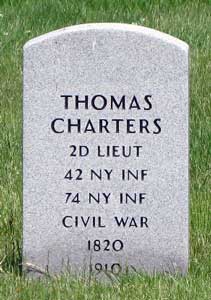
CHARTERS, THOMAS (1820-1910). Second lieutenant, 74th New York Infantry, Company D; private, 42nd New York Infantry, Companies K and I. Born in New York City, the Brooklyn Directory for 1857-1862 notes that he was a silversmith at 12 Maiden Lane in New York City and lived on DeKalb Avenue in Brooklyn. Charters enlisted at enlisted at Long Island as a private on June 22, 1861, mustered into Company K of the 42nd New York six days later, and was transferred to Company I that day. As per his muster roll, he was employed as a silversmith and was 5′ 9″ tall with a dark complexion, grey eyes and grey hair. Charters deserted on July 16, 1861, at Great Neck, Long Island.
His pension records indicate that he was told that if he raised a certain number of recruits he would be given a commission as a lieutenant. On December 1, 1862, Charters was commissioned as a second lieutenant and mustered into the 74th Infantry’s Company D on the field at Petersburg, Virginia. At some point, he was shot in the right ear with a spent ball, and mustered out on June 26, 1864, at Petersburg. His application for an invalid pension was granted, certificate 1,132,713. He last lived at 607 St. Marks Avenue, Brooklyn. His cause of death was arteriosclerosis. Section 195, lot 26503, grave 6.
CHARTERS, WILLIAM F. (1825-1870). Private, 23rd Regiment, New York State National Guard, Company B. Charters served in the 23rd Regiment when it was activated for 30 days in 1863. He last resided at 103 Crosby Street in Manhattan. Section 127, lot 17931, grave 248.
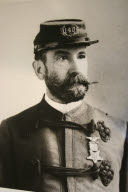
CHASE, JR., AMOS M. (1841-1911). Private, 7th Regiment, New York State National Guard, Company B. A native of New York City, he enlisted there on May 25, 1862, served in the 7th for three months, and mustered out on September 2. He is listed as working in the cotton business in the Brooklyn Directory for 1867-1870, and is identified as an agent in the Brooklyn Directory for 1873-1876; during those years, he lived at 114 Milton Street. He belonged to the Lafayette Post #140 of the G.A.R. Chase died from arteriosclerosis. His last home was in the Dorchester neighborhood of Boston, Massachusetts. Section 12, lot 8884.
CHASE, BENJAMIN H. (1828-1879). Private, 7th Connecticut Infantry, Company D. Born in Norwalk, Connecticut, and a resident of Watertown, Connecticut, Chase enlisted on February 18, 1864, as a private. He immediately mustered into the 7th Connecticut from which he was discharged for disability on April 22, 1864. Most likely, he was the brother of Edwin Chase (see) who served in the same regiment. He last lived in Norwalk, Connecticut. The cause of his death was pneumonia. Section 27, lot 9104.
CHASE, CHARLES (1792-1877). Surgeon, United States Navy. A native of Maine, Chase attended medical school and served for many years in the United States Navy as a surgeon. He began as a surgeon’s mate on December 10, 1814, rose to surgeon on May 3, 1825, and retired on December 21, 1861. He was listed as a medical director on the retired list on March 3, 1871. He is listed as being in the U.S. Navy in the Brooklyn Directory for 1870-1873; at that time, he lived at 160 Ryerson Street. He retired from practice in 1875. His last residence was 182 Willoughby Avenue in Brooklyn. His death was attributed to old age and debility. Section 112, lot 13984.
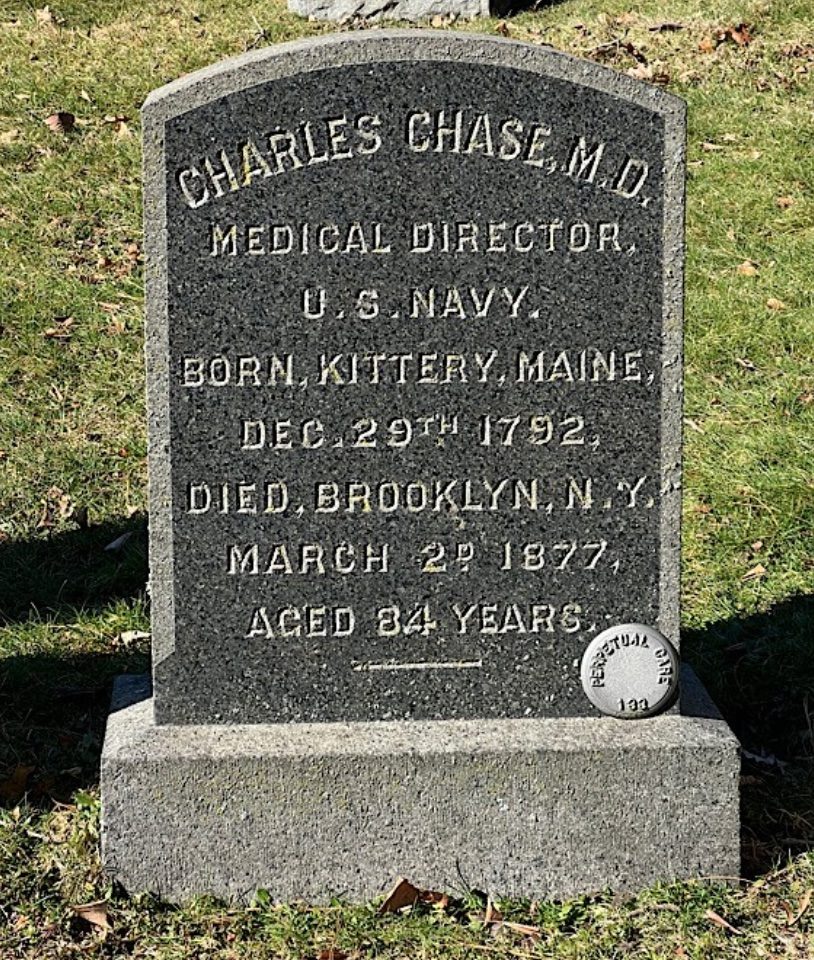
CHASE, CHARLES S. (1841-1879). Private, 18th New York Cavalry, Company K. After Chase enlisted at New York City on December 9, 1863, he mustered into the 18th New York Cavalry on December 22. Sometime later he deserted, though the date was not noted in his service record. An epileptic, Chase was living at the Home for Incurables in New York when he died from that disease. Section 51, lot 12802.
CHASE, EDWIN (or EDWARD) V. (?-1914). Private, 7th Connecticut Infantry, Company D. A resident of Wilton, Connecticut, he enlisted as a private on February 22, 1864, and mustered that day into the 7th Connecticut. Taken as a prisoner of war near Richmond, Virginia, on July 20, 1864, he was paroled on an unstated date and mustered out at Goldsboro, North Carolina, on July 20, 1865. He may be the Edwin V. Chase who is listed as a smith in the New York City Directory for 1882-1883; that man lived at 174 East 91st Street. Most likely, he was the brother of Benjamin Chase (see) who served in the same regiment. He died from a cerebral thrombosis (blood clot in the brain). Section 27, lot 9104.
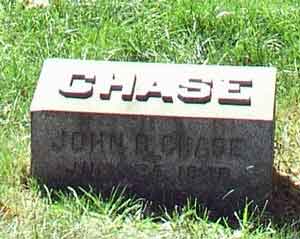
CHASE, JOHN B. (1840-1907). Private, 10th New York Infantry, Company G. Born in Nantucket, Massachusetts, Chase was living there in 1850 and then resided in Bristol, Massachusetts, in 1860. He enlisted as a private at New York City on April 26, 1861, and mustered into the 10th New York four days later. He mustered out on May 6, 1863, at New York City.
The New York City Directories for 1873-1876, 1875-1876 and 1876-1878 list Chase in gentlemen’s furnishings at 47 Nassau Street; at that time, he lived on Willow Street in Brooklyn. According to the 1880 census, he was in the business of “furnishing goods.” He is also listed in “Gent’s Furnishing Goods” at 101 Fulton Street in the Brooklyn Directory for 1880-1882; he was in the same business at 154 Fulton Street in the Brooklyn Directory for 1890-1892.
A member of Winchester Post #197 of the G.A.R., he held the position of commander at one time. On February 22, 1891, he and four other members of his G.A.R. Post and another un-named veteran traveled to Ozone Park, Queens, to donate skin to help a fellow soldier who needed a skin graft as a result of injuries suffered at the Battle of Gettysburg, Pennsylvania. In an article the next day in the Brooklyn Daily Eagle, it was reported that the veteran-in-need, Captain William Kay of the 70th New York, suffered from a wartime-leg wound that continued to seep and bleed. After a nine pound shot went though Kay’s horse at Gettysburg, it damaged his left calf, and a surgeon sewed the ragged edges of the skin together. Kay remained in service until 1870. By 1890, after numerous operations, his leg gave out, and requests were made at the Winchester Post, where Kay was a past commander, for volunteers to donate skin for the transplant. Chase was among the five chosen from all the volunteers. Dr. William Chase and Dr. Samuel Nutt of Ozone Park performed the operation during which pieces of skin from John Chase (no relation to the surgeon) and the volunteer who accompanied the Winchester members were the only ones selected for the procedure. Captain Kay thanked the two men in the Brooklyn Daily Eagle piece, not knowing the stranger’s name, but grateful that he had undergone such pain to help a comrade.
Chase applied for and was granted a pension in 1904, certificate 1,084,134. He last lived at 277 Park Place in Brooklyn. Shortly after his death from apoplexy in 1907, Cornelia Chase, who is interred with him, applied for and received a widow’s pension, certificate 637,986. Section 153, lot 24042.
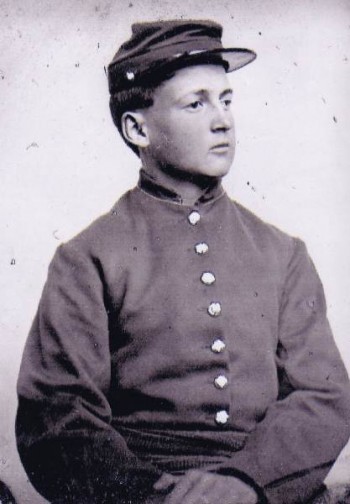
CHEESEMAN (or CHESSMAN), WILLIAM R. (1847-1892). Drummer, 42nd New York Infantry, Companies G and C. Born in New York, Cheeseman enlisted at Long Island as a private on June 28, 1861 (he was 14 at the time, though his service records state he was 16). He mustered into Company G of the 42nd New York, also known as the Tammany Regiment, and was transferred the next day to Company C. This company saw considerable action in the Civil War. He was listed as present with the 42nd Infantry on July 3, 1863, when it helped stop Pickett’s Charge at the Battle of Gettysburg. According to his great-grandson, Cheeseman’s daughter said that during his service he was used as a spy to reconnoiter behind Confederate lines. He mustered out on July 13, 1864, at New York City.
William R. Cheesman is listed as a driver/cartman in the 1876-1878 New York City Directory and is listed as a painter in the 1885-1886 Brooklyn Directory. He owned a “White Shamrock – Union 2nd Corps” badge, a photocopy of which was made available by his great-grandson. With that badge there is a note, in Cheeseman’s hand: “The Badge of the brave 2nd Corps. I do not think in all this length of time since the war any of my comrades can show one.” He applied for an invalid pension in 1891, application 1,035,689. His last residence was 183 2nd Avenue in Manhattan. Cheeseman died from nephritis. His widow, Mary, applied for a pension in 1892 that was granted under certificate 344,991. Section 59, lot 1821, grave 14.
CHEESMAN (or CHEESEMAN), TIMOTHY MATLACK (1825-1888). Surgeon, 7th Regiment, New York State Militia. Cheesman was born in New York City. On December 5, 1848, he became a member of the Saint Nicholas Society of New York, an organization of men descended from early inhabitants of New York. After enlisting at New York City on April 17, 1861, he was commissioned into the Field and Staff of the 7th Regiment nine days later, and mustered out on June 3, 1861, at New York City. He is listed as a physician in the New York City Directory for 1876-1878 and the Brooklyn Directory for 1885-1886. He last lived at 12 West 22nd Street in Manhattan. He died from Bright’s disease. He was survived by his wife, Maria Louisa Smith Cheesman and one daughter; three children pre-deceased him, two as youngsters. An oil portrait of Cheesman, in uniform, painted by Charles Loring Elliot, circa 1855, is in the collection of the Museum of the City of New York. Section 83, lot 5485.
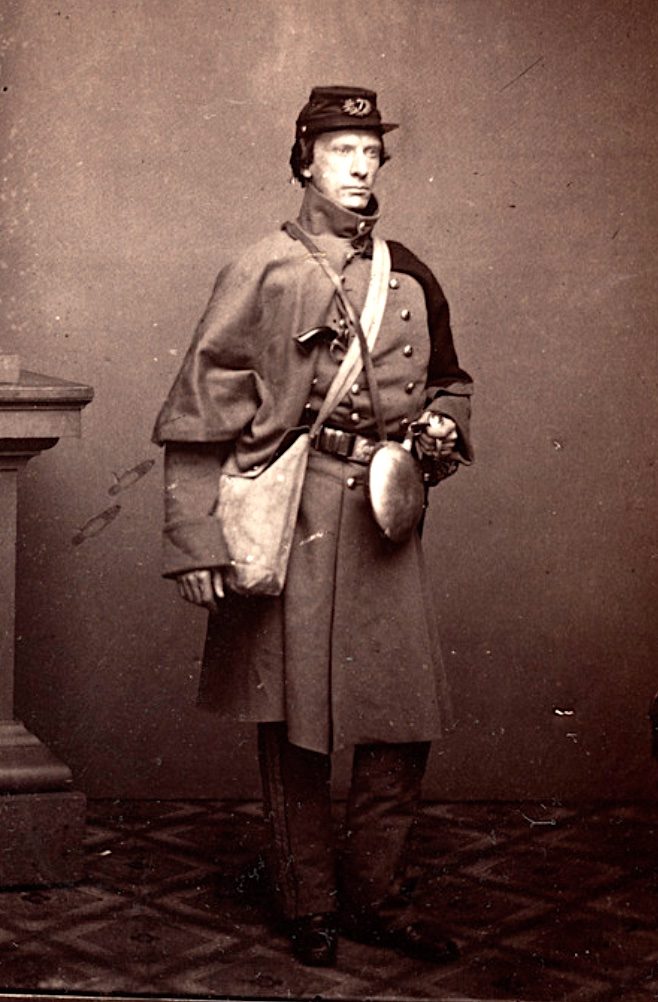
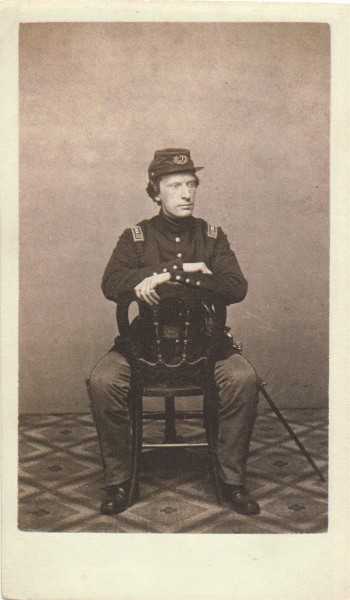
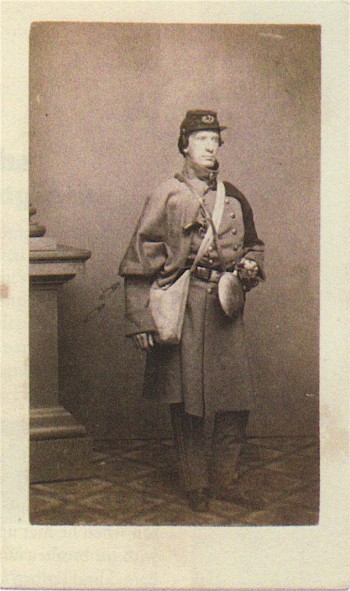
CHEEVER (or CHEEVERS), EUGENE S. (or B.) (1845-1874). Private, 11th New York Infantry, Company E. Born in New York City, he enlisted there on April 20, 1861, and mustered into the 11th New York on May 7. He mustered out of service on June 2, 1862, at New York City. His last residence was 401 Third Avenue in Manhattan. Cheever died from tuberculosis. Section A, lot 9146, grave 465.

CHEEVER, GEORGE BARRELL (1807-1890). Abolitionist, religious and social reformer. Born in Hallowell, Maine, he was a son of Nathaniel Cheever, editor of the American Advocate. A graduate of Bowdoin College in 1825, he was a classmate of Henry Wadsworth Longfellow and Nathaniel Hawthorne. In 1830, he graduated from Andover Seminary and was ordained pastor of Boston’s Howard Street Congregational Church two years later. In 1831, he wrote, The American Common-Place Book of Poetry. A temperance and anti-slavery advocate, Cheever became embroiled in controversy when he wrote an allegory, “Inquire at Deacon Giles’s Distillery” that was published in a Salem, Massachusetts, newspaper in 1835. Friends of the deacon rebelled and Cheever was sued for libel and later imprisoned for thirty days.
In 1839, Cheever relocated to New York City where he led the Allen Street Presbyterian Church and became known for his fervent lectures that addressed the issues of the day. As per Philip English Mackey in Reverend George Barrell Cheever: Yankee Reformer as Champion of the Gallows, Cheever was a leader of the movement against the ending of capital punishment for murder in New York State in the 1840s; his sermons were published in “Punishment by Death”; ultimately, the bill failed in Albany and the efforts of the clergy to cite divine arguments were declared to be the reason. After engaging in three public debates in 1843 with J. L. O’Sullivan who favored ending capital punishment, Cheever soon became known as “the champion of the gallows in America.” He gave a series of lectures on The Pilgrim’s Progress which were included in a book in 1844. From 1846-1870, Cheever was pastor of the Church of the Puritans, in New York City, which was organized for him. In 1851, he edited Christian Melodies, which contained nineteen hymns that he composed.
A zealot, he called upon the Lincoln Administration to repudiate slavery and for the “extermination of southern slaveholders in general.” He and fellow parson William Goodell visited President Abraham Lincoln on December 31, 1862, to plead with the president to issue the Emancipation Proclamation; Lincoln replied, “Tomorrow at noon, you shall know”–and the country shall know–my decision.”
Cheever presented a flag to the 1st South Carolina Volunteers at Camp Saxton in Morris Island on January 1, 1863, after the Emancipation Proclamation was read. That reading was followed by an ox roast and celebration. On February 9, 1866, when Lieutenant Colonel C. T. Trowbridge gave his farewell address to the 33rd United States Colored Troops (formerly the 1st South Carolina), he noted that the flag presented by Cheever would be rolled up and brought to the nation’s capital. Trowbridge went on to say, “…While there it shall rest, with the battles in which you have participated inscribed upon its folds, it will be a source of pride to us all to remember that it has never been disgraced by a cowardly faltering in the hour of danger or polluted by a traitor’s touch….”
An article in The New York Times on December 7, 1863, described a debate proposal by Cheever to the Reverend Henry Ward Beecher (see) in which Cheever proposed, “…I invite you to argue that the Government was ever bound not to interfere against Slavery; I will prove that such interference was and is its first obligation, both by the law of Christianity and the Constitution….” Beecher declined the invitation.
After 1870, Cheever left the ministry and devoted his time to literary criticism, journalism, lecturing and editing. According to his obituary in The New York Times, he was a prolific writer who contributed to the Observer, the Independent and the Bibliotheca Sacra. Among his articles were “Defense of Capital Punishment” (1841); “The Right of the Bible in Our Public Schools (1846); “God Against Slavery, and the Freedom and Duty of the Pulpit to Rebuke It” (1851); and “Guilt of Slavery and Crime of Slaveholding (1860). A widower, he last lived in Englewood, New Jersey; his wife, Elizabeth Hoppin Wetmore Cheever, died in 1886. His death was attributed to dysentery. Section 35, lot 9306.
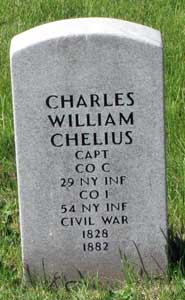
CHELIUS, CHARLES WILLIAM (1828-1882). Captain, 29th New York Infantry, Company C; 54th New York Infantry, Company I. Chelius, who was originally from Germany, enlisted as a second lieutenant on May 9, 1861, at New York City, and mustered into the 29th New York on June 4. He rose through the ranks and was promoted to first lieutenant on August 2, 1861, and then became captain on December 23, 1862, remaining in that position until he mustered out on June 20, 1863, at New York City. On January 12, 1864, he re-enlisted as a captain and was commissioned into Company I of the 54th New York. He mustered out while awaiting the sentence of general court-martial.
In 1881, his application for a pension was approved, certificate 403,550. Chelius died from peritonitis at the German Hospital in New York City. His widow, Caroline, applied for a pension shortly after his death in 1882 that was granted under certificate 248,509. Section 2, lot 5499, grave 980.
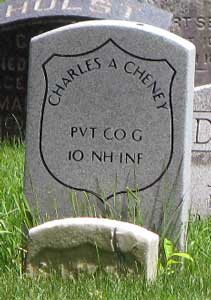
CHENEY, CHARLES A. (1834-1892). Private, 10th New Hampshire Infantry, Company G; 15th Massachusetts Light Artillery; 6th Massachusetts Light Artillery, Battery B. Born in Hooksett, New Hampshire, he enlisted there at Greenland on September 9, 1862, and mustered into the 10th New Hampshire four days later. He was discharged for disability on April 11, 1863. On May 15, 1863, he applied for and received an invalid pension under certificate 661,596. Living in Lowell, Massachusetts, and employed as a painter, he re-enlisted on November 28, 1863, and mustered immediately into the 15th Massachusetts. On January 5, 1865, he transferred into the 6th Massachusetts from which he was discharged for disability on May 29 of that year at New Orleans, Louisiana.
According to the New York City Directories for 1877 and 1882-1883 and the census of 1880, he was working as a painter. The 1890 Veterans Schedule confirms his military service. He last resided at 158 Ninth Avenue in New York City. Cheney died from heart disease. A government-issued stone marks his grave. Frances Cheney, his widow, applied for a pension in 1892, application 557,358, but there is no indication that it was certified. Section 135, lot 27263, grave 1790.
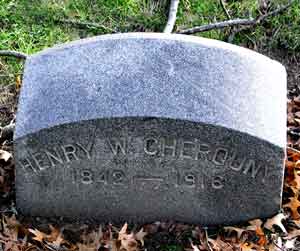
CHEROUNY (or CHEVAUNEY, CHERRUM, CHERRONNEY), HENRY WILLIAM (1842-1916). Private, 2nd Missouri Volunteers, Company A; 1st New York Marine Artillery, Company A. Cherouny was born in Halle, Prussia, and immigrated to the United States in 1854 from Bremen on board the bark New Orleans. His birth name was Heinrich August Wilhelm Cherouny. By 1860, when he married his first wife, Mary, he was a printer in St. Louis; the couple had eight children, five of whom survived childhood. He was 5′ 10″ tall, had blue eyes, and was living in St. Louis, Missouri, when he responded to “Lincoln’s proclamation and call for 75,000 men” in April 1861, at which time he mustered into Company A of the 2nd Missouri Volunteers as a private. He was honorably discharged on July 30, then re-enlisted at Philadelphia, Pennsylvania, on November 12, 1861, as a private in the 1st New York Volunteer Marine Artillery. While serving on the transport Dragoon, he fell from a mast and suffered a severe concussion and a complete loss of hearing on his right side. He was discharged on December 5, 1862, at New Berne, North Carolina.
On October 24, 1864, Cherouny became a naturalized citizen of the United States. In civilian life, he was a publisher and printer by trade whose firm that ultimately bore his name was at 17 Vandewater Street in New York City. He also wrote and published The Burial of the Apprentice; A True Story From Life in a Union Workshop and Other Essays on Present Political and Social Problems and Socialism and Christianity: Sober Thoughts for All Who Are Concerned in the Welfare of Our Industry; he also translated and published A Criticism of Darwinism by Otto Effertz, M.D.
His personal life was marked by controversy and a sensational divorce. As per an article in the Brooklyn Daily Eagle on June 20, 1886, Cherouny separated from his first wife in 1868, paid $6 a week alimony until he filed for divorce in 1886 after living for several months with his eldest daughter in Germany; his wife declared that he fled to Germany after their son removed furnishings from her sparse apartment. The court proceedings, prior to the divorce, pitted members of the family against each other. At the time of the divorce, Cherouny was living with Elizabeth Fredericks (née Fandrich), who worked for him; the couple had a son. Ultimately, alimony was increased to $10 per week in November 1886. Cherouny re-married in 1888 and had a daughter.
Cherouny applied for a pension in 1904, certificate 1,106,273, and declared the pension in August 1912, under the act of May 11, 1912. At the time he applied for a passport in 1912 for a trip of four months, he indicated that he was still employed as a printer. He described himself as 5’8″ tall (two inches shorter than when he enlisted), with a strong nose, white hair, round face, and normal chin.
As per his obituary in the New York Evening Star, which confirms his Civil War service, Cherouny was an original member of the Printers’ League, an organization of master printers in New York City, and was also a member of the Ulysses S. Grant Post #327 of the G.A.R. and the Theosophical Society, an organization founded to explore religious, scientific and philosophical truths and share that knowledge with others. His obituary in the Brooklyn Standard Union notes that members of his G.A.R. Post held services in his honor. His last residence was 1438 51st Street in Brooklyn. His death was attributed to nephritis. His widow, Elizabeth, was recognized as the lawful claimant of his pension in June 1916 (certificate 808,881), after a review of Henry’s divorce from his first wife, Mary. Section 19, lot 11202.
CHERRY, JOHN G. (1836-1863). Private, 19th Illinois Infantry, Company A. A New York State native, Cherry enlisted as a private on June 17, 1861, at Chicago, Illinois, and mustered into the 19th Illinois that day. Beginning in December 1862, the 19th Illinois fought valiantly as it moved from Nashville, Tennessee, to Franklin Pike and then Breckenridge and Stone River. He was killed in action at the Battle of Murfreesboro, Tennessee, on April 20, 1863, and was interred at Green-Wood on August 30. Section 180, lot 13204.
CHILD, JAMES M. B. (1843-1884). Third lieutenant, United States Revenue Marines. A native of Massachusetts, Child was appointed third lieutenant in the Revenue Marine Service on March 7, 1865, and resigned his commission on September 1, 1865. After the War, he was an officer in the Customs House. Originally buried at Cypress Hills Cemetery on February 11, 1884, his remains were removed and re-interred at Green-Wood on May 1 of that year. His last residence was at 76 2nd Place, Brooklyn. Section A, lot 16610.
CHILDS, CHARLES (1848-1918). Sailor, United States Navy. Born in Germany, Childs served in the Navy during the Civil War. Further details are unknown. His last residence was at 467 Hamburg Avenue in Brooklyn. His death was attributed to peritonitis. Section B, lot 10005, grave 256.
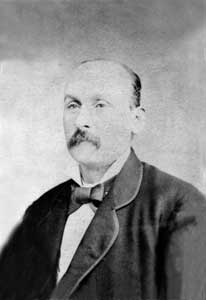
CHIN (or CHINN), WILLIAM (1840-1890). Sergeant, 10th New York Infantry, Company F. Chin was born in England. He enlisted at Brooklyn on April 26, 1861, and mustered in as a private four days later. During his service, he was promoted to sergeant, then mustered out on May 7, 1863, at New York City.
Chin married Emma Maria Smith in 1867. In 1869, when the old Volunteer Fire Department was reorganized, he served as a driver on Engine #1, then was transferred to Engine #20. In 1874, he applied for and received an invalid pension, certificate 129,252. Chin was a member of Winchester Post #197 of the G.A.R.
According to an article in the Brooklyn Daily Eagle, Chin was injured en route to the Brasher Oilcloth Works fire on Eighth Avenue and 18th Street when Engine #20 was run over by Supply Wagon #9 on December 28, 1889; he died shortly after his injury on January 3, 1890. Emma Chin, his widow, sued the city for negligence, citing a defect in the street that led to her husband being thrown from his truck. The defense argued that the street was not in disrepair and that Chin was leaning over the dashboard reaching for a rein when he was jolted as his truck hurried to the fire over the slight depression in the road. Her suit, seeking $5,000 in damages in City Court, was dismissed on January 21, 1891, after the jury deadlocked at 11-1 in her favor, but could not reach a unanimous verdict.
Shortly after her husband’s death in 1890, Emma Chin applied for and received a widow’s pension, certificate 346,973. Four children survived him, three other children, who died as youngsters, predeceased him. According to a descendant, the correct spelling of the family name is Chinn. A life-size sculpted marble fireman marks his grave and that of several others who lost their lives in the service of the City of Brooklyn. Section 200, lot 27009.
